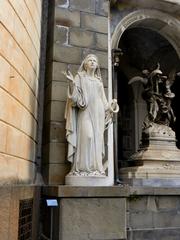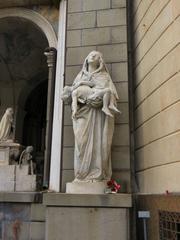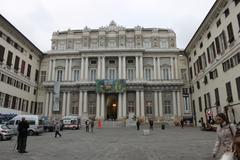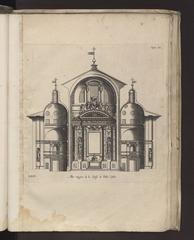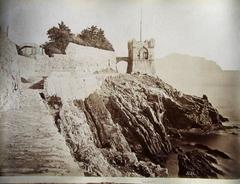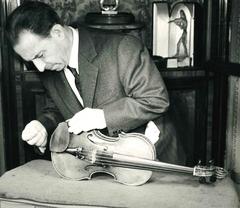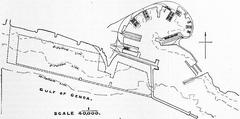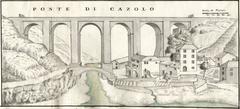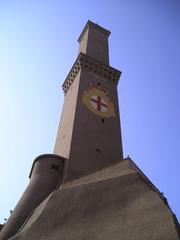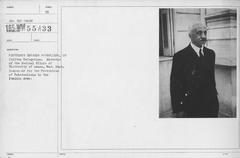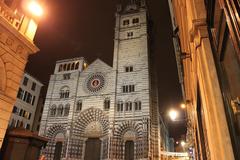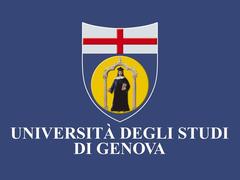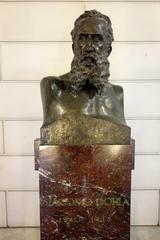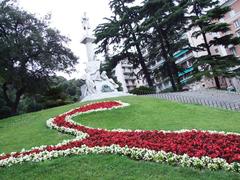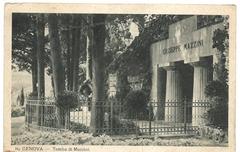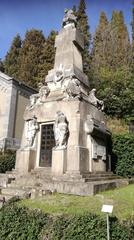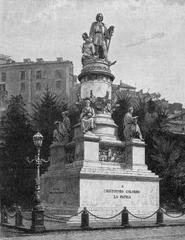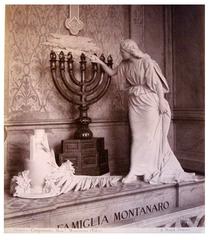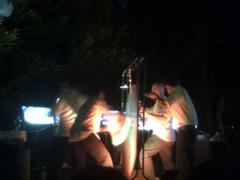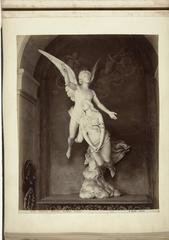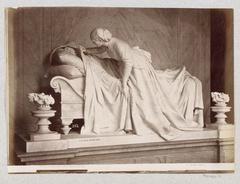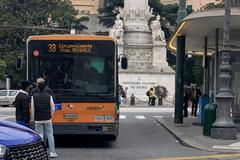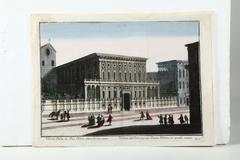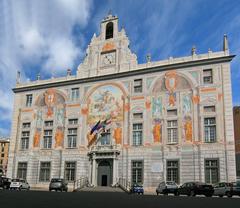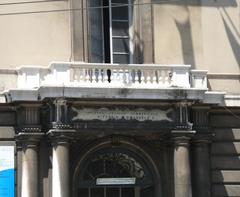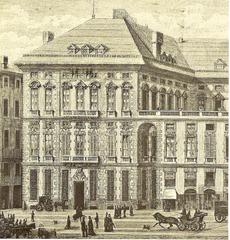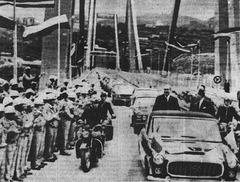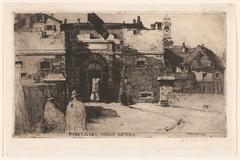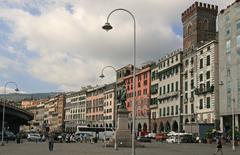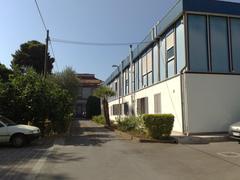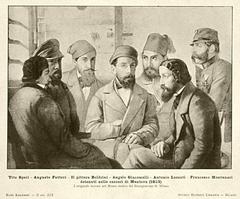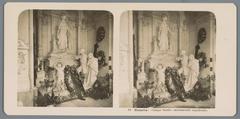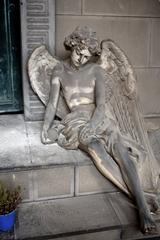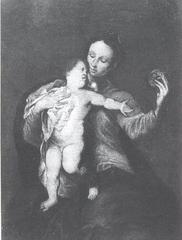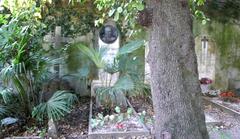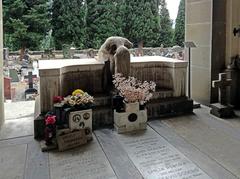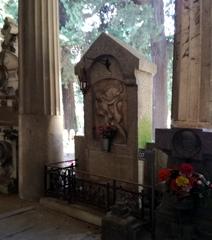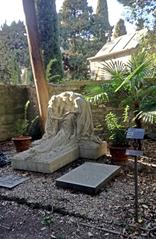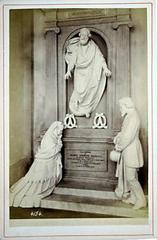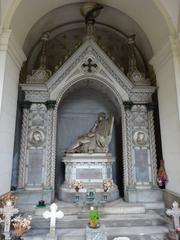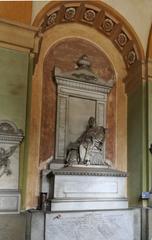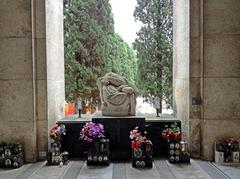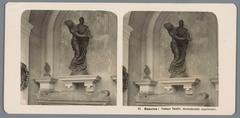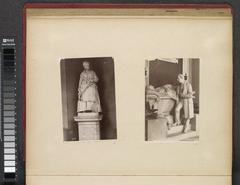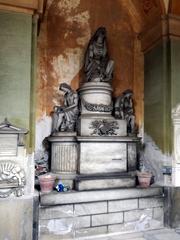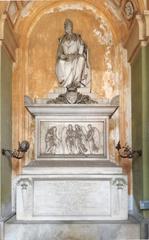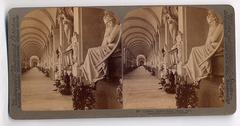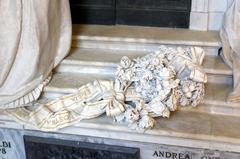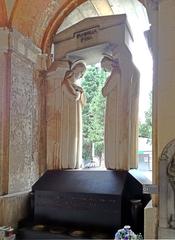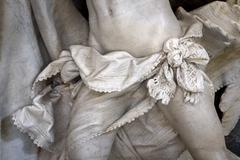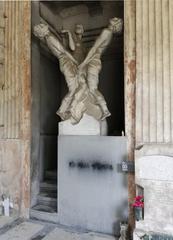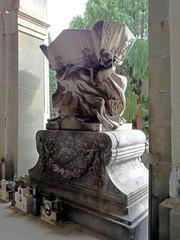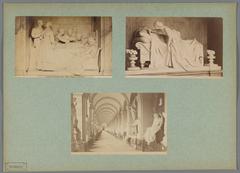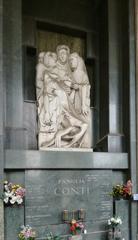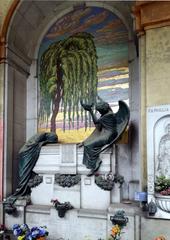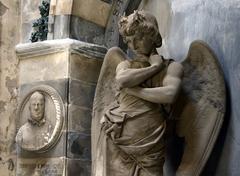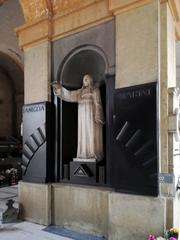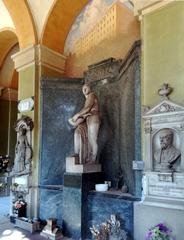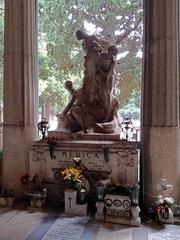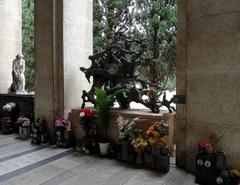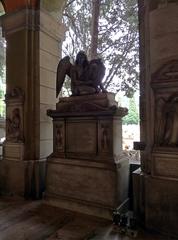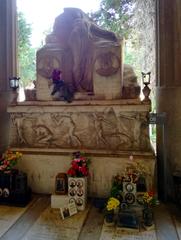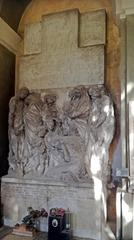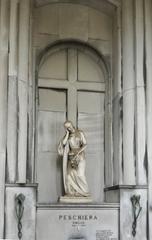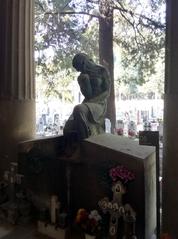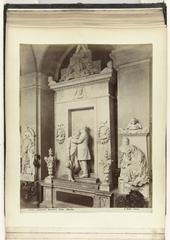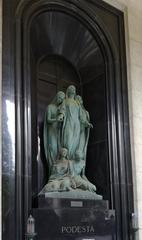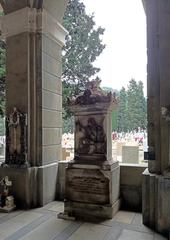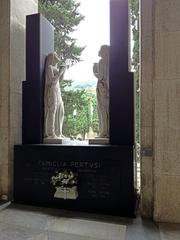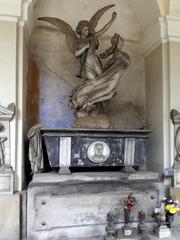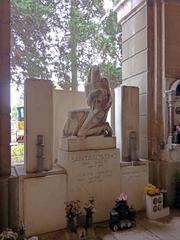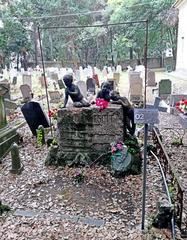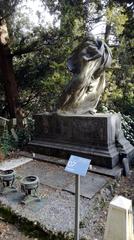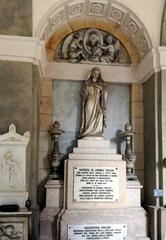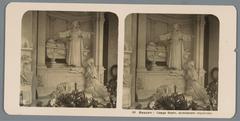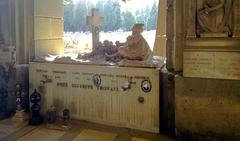विला सेंटूरिओन डेल मोनास्टेरो: जियानो, इटली की यात्रा के घंटे, टिकट की जानकारी और पूर्ण मार्गदर्शिका
दिनांक: 14/06/2025
परिचय
विला सेंटूरिओन डेल मोनास्टेरो जियानो के सबसे आकर्षक ऐतिहासिक स्थलों में से एक है, जो सदियों की धार्मिक, कुलीन और कलात्मक विरासत को एक साथ जोड़ता है। सैम्पिएरडेरेना के केंद्र में स्थित, यह विला 13वीं सदी के बेनेडिक्टिन मठ से अपनी जड़ें जमाता है और पुनर्जागरण और बारोक काल के दौरान जियानो की वास्तुकला और सांस्कृतिक विरासत के एक उल्लेखनीय उदाहरण के रूप में विकसित हुआ है। आज, यह न केवल शहर के अतीत का स्मारक है, बल्कि संस्कृति, शिक्षा और सामुदायिक जीवन का एक जीवंत केंद्र भी है। यह मार्गदर्शिका विला के इतिहास, आगंतुक घंटों, टिकट, पहुंच, यात्रा युक्तियों और बहुत कुछ पर विस्तृत जानकारी प्रदान करती है, ताकि आप अपनी यात्रा का अधिकतम लाभ उठा सकें।
ऐतिहासिक अवलोकन
मध्ययुगीन उत्पत्ति
विला की कहानी 1221 में शुरू होती है, जब इस स्थल पर सांता मारिया डेल सैंटो सेपोल्क्रो को समर्पित एक बेनेडिक्टिन कॉन्वेंट की स्थापना की गई थी (विले स्टोरिच संपिएरडेरेना). मध्ययुगीन मठ, जो कुछ बचे हुए तत्वों में से एक है, जियानो के पवित्र मठवासी इतिहास की एक दुर्लभ झलक प्रदान करता है। 1514 में, कॉन्वेंट को पोप के फरमान द्वारा दबा दिया गया, संक्षेप में ऑगस्टिनियन फादर्स के पास चला गया, इससे पहले कि यह प्रमुख सेंटूरिओन परिवार द्वारा अधिग्रहित किया गया।
पुनर्जागरण परिवर्तन
1587 में, बर्नबा सेंटूरिओन स्कॉटो ने एस्टेट को “डिमोरा डि डेलिज़िया,” या आनंद निवास में बदल दिया (it.wikipedia.org). नए विला में एक आयताकार योजना, भव्य लॉजिया और व्यापक उद्यान थे, जिसमें मध्ययुगीन संरचना के अवशेषों को सहज रूप से एकीकृत किया गया था। प्रवेश द्वार पर अलंकृत बेस-रिलीफ और तराशे हुए रूपांकनों—जैसे कि ट्राइटन और ड्रैगन—परिवार की स्थिति और जियानो की कलात्मक महत्वाकांक्षाओं को दर्शाते हैं।
बारोक और बाद के विकास
विला 1684 के फ्रांसीसी बमबारी के दौरान क्षतिग्रस्त हो गया था, जिससे 1750 में एबोट जियोल्फी के तहत महत्वपूर्ण बहाली और शैलीगत अद्यतन हुए (विले स्टोरिच संपिएरडेरेना). नेपोलियन युग के दौरान, संपत्ति को नगरपालिका उपयोग के लिए अधिग्रहित कर लिया गया था, इससे पहले कि यह निजी हाथों में वापस आ जाए, फिर 1850 में एक नागरिक विद्यालय और पुस्तकालय के रूप में पुन: उपयोग किया गया। 1912 में एक प्रमुख नव-पुनर्जागरण फेसलिफ्ट ने स्टुको कॉर्निस, टिम्पाना और सजावटी ब्रैकेट जोड़े - ऐतिहासिक भव्यता को 20वीं सदी की शुरुआत के स्वाद के साथ मिश्रित किया (कॉम्यून डि जियानो).
वास्तुकला और कलात्मक मुख्य आकर्षण
मध्ययुगीन मठ
विला के आंगन में एकीकृत, मध्ययुगीन मठ में प्राचीन मेहराब और पत्थर का काम है, जो मूल कॉन्वेंट के आध्यात्मिक वातावरण को संरक्षित करता है (विले स्टोरिच संपिएरडेरेना). यह शांत स्थान विला के बाद के पुनर्जागरण और बारोक विवरणों के साथ खूबसूरती से विपरीत है।
पुनर्जागरण और बारोक विशेषताएँ
विला अपनी 16वीं सदी की आयताकार योजना और सममित लॉजिया को बरकरार रखता है, जबकि प्रवेश बेस-रिलीफ और तराशे हुए ड्रैगन युग के पौराणिक और कलात्मक प्रभावों को दर्शाते हैं (रेस्टॉरो ई कंजरवेशन). अंदर, आगंतुकों को ओविड के मेटामोर्फोसिस और वर्जिल के एनीड से प्रेरित भित्तिचित्रों का एक समृद्ध चक्र मिलेगा, जो सेंटूरिओन परिवार की बौद्धिक आकांक्षाओं को दर्शाता है।
साला बारबिनो और कलात्मक खजाने
एक मुख्य आकर्षण पियानो नोबिल पर भव्य हॉल, साला बारबिनो है, जो बर्नार्डो कैस्टेलो (1557-1629) के भित्तिचित्रों से सजाया गया है। 2025 में पूरा हुआ सबसे हालिया जीर्णोद्धार, ईंट-और-प्लास्टर वॉल्ट को स्थिर किया, लकड़ी के काम की मरम्मत की, और भित्तिचित्रों को सावधानीपूर्वक साफ किया। 20वीं सदी की शुरुआत के दो बहाल वेनिस ग्लास झूमर अब इस स्थान को रोशन करते हैं, जो जियानो की कलात्मक विरासत को उजागर करते हैं (प्रिमोकेनाल; कॉम्यून डि जियानो).
बहाली और संरक्षण
विला सेंटूरिओन डेल मोनास्टेरो ने हाल के वर्षों में महत्वपूर्ण बहाली प्रयासों से लाभान्वित हुआ है। इनमें शामिल हैं:
- बर्नार्डो कैस्टेलो द्वारा भित्तिचित्रों का संरक्षण, जीवंत मूल रंगों को प्रकट करना।
- न्यूनतम इनवेसिव तकनीकों का उपयोग करके ऐतिहासिक चिनाई का संरचनात्मक सुदृढीकरण।
- मौसम और पर्यावरणीय क्षति से बचाने के लिए मुखौटा और छत की मरम्मत।
- प्रतिष्ठित रक्षात्मक टॉवर के संरक्षण और ऐतिहासिक उद्यानों की बहाली।
इन पहलों को इतालवी पर्यटन मंत्रालय और स्थानीय विरासत परियोजनाओं द्वारा समर्थित किया गया है, यह सुनिश्चित करते हुए कि विला आधुनिक दर्शकों के लिए सुलभ और प्रासंगिक बना रहे (कॉम्यून डि जियानो).
आगंतुक जानकारी
स्थान और वहां कैसे पहुंचें
- पता: पियाज़ा डेल मोनास्टेरो 6, सैम्पिएरडेरेना, जियानो, इटली
- सार्वजनिक परिवहन: जियानो शहर के केंद्र से बसों (लाइनों) और सैम्पिएरडेरेना स्टेशन के लिए ट्रेन से आसानी से पहुँचा जा सकता है, जिसके बाद एक छोटी पैदल दूरी तय करनी होती है।
- पार्किंग: आस-पास सीमित पार्किंग है; सार्वजनिक परिवहन की सिफारिश की जाती है।
आगंतुक घंटे
- सार्वजनिक रूप से खुला: विशेष सांस्कृतिक कार्यक्रमों के दौरान, विशेष रूप से रोली डेज़ (वसंत और शरद ऋतु) के दौरान।
- विला मुख्य रूप से एक स्कूल और पुस्तकालय के रूप में कार्य करता है, इसलिए इन अवसरों के बाहर दैनिक यात्राएं संभव नहीं हैं।
टिकट और निर्देशित पर्यटन
- प्रवेश: रोली डेज़ और अधिकांश सार्वजनिक कार्यक्रमों के दौरान मुफ्त (रोली डेज़ कार्यक्रम).
- निर्देशित पर्यटन: कार्यक्रमों के दौरान पेश किया जाता है; सीमित उपलब्धता के कारण उन्नत बुकिंग की सिफारिश की जाती है।
- समूह यात्राएं: कभी-कभी कॉम्यून डि जियानो से संपर्क करके व्यवस्थित किया जा सकता है।
पहुंच
- व्हीलचेयर पहुंच: मुख्य क्षेत्रों में उपलब्ध है, हालांकि कुछ ऐतिहासिक खंडों में सीढ़ियां और असमान सतहें हैं। विशेष आवासों के लिए पहले संपर्क करें।
आगंतुक युक्तियाँ
- घूमने का सबसे अच्छा समय: वसंत और शरद ऋतु, रोली डेज़ के साथ मेल खाता है।
- फोटोग्राफी: अधिकांश क्षेत्रों में अनुमति है, लेकिन नाजुक कलाकृतियों के लिए प्रतिबंध लागू हो सकते हैं।
- आगंतुक शिष्टाचार: संरक्षण प्रयासों का सम्मान करें और गाइडों के निर्देशों का पालन करें।
क्या देखें
- मध्ययुगीन मठ: दुर्लभ मठवासी अवशेष, शांत और वायुमंडलीय (विले स्टोरिच संपिएरडेरेना).
- साला बारबिनो: बर्नार्डो कैस्टेलो और वेनिस ग्लास झूमर द्वारा आश्चर्यजनक भित्तिचित्र (प्रिमोकेनाल).
- वास्तुकला विवरण: बेस-रिलीफ, ड्रैगन और नव-पुनर्जागरण मुखौटा तत्व (रेस्टॉरो ई कंजरवेशन).
आस-पास के आकर्षण और यात्रा युक्तियाँ
- अन्य सैम्पिएरडेरेना विला का अन्वेषण करें: विला इम्पेरियल, विला डोरीया और सार्वजनिक उद्यान (“इल जार्डिनो यूरोपियो”) (कॉम्यून डि जियानो).
- भोजन: आस-पास के कैफे और रेस्तरां में लिगुरियन व्यंजनों का आनंद लें।
- यात्राओं को मिलाएं: रोली डेज़ स्थलों या जियानो के ऐतिहासिक केंद्र के आसपास अपनी यात्रा कार्यक्रम की योजना बनाएं।
सामान्य प्रश्न (FAQs)
प्रश्न: क्या विला सेंटूरिओन डेल मोनास्टेरो साल भर खुला रहता है? ए: नहीं, सार्वजनिक पहुंच मुख्य रूप से रोली डेज़ जैसे विशेष कार्यक्रमों के दौरान होती है।
प्रश्न: मैं दौरे के लिए कैसे बुक करूं? ए: सार्वजनिक उद्घाटन के दौरान निर्देशित पर्यटन के लिए अग्रिम आरक्षण आवश्यक है; रोली डेज़ या कॉम्यून डि जियानो वेबसाइटों की जाँच करें।
प्रश्न: क्या मैं सीमित गतिशीलता के साथ जा सकता हूँ? ए: मुख्य क्षेत्र सुलभ हैं; विवरण के लिए कर्मचारियों से संपर्क करें।
प्रश्न: क्या प्रवेश शुल्क हैं? ए: रोली डेज़ के दौरान प्रवेश आम तौर पर मुफ्त होता है; बुकिंग की सलाह दी जाती है।
प्रश्न: क्या फोटोग्राफी की अनुमति है? ए: हाँ, नामित क्षेत्रों को छोड़कर।
दृश्य और मीडिया
- छवि सुझाव: “विला सेंटूरिओन डेल मोनास्टेरो मुखौटा जियानो में” जैसे ऑल्ट टेक्स्ट के साथ बाहरी दृश्य; मध्ययुगीन मठ; साला बारबिनो भित्तिचित्र।
- इंटरैक्टिव मानचित्र: सैम्पिएरडेरेना और विला स्थान का एम्बेडेड मानचित्र।
- वर्चुअल टूर: डिजिटल संसाधनों के लिए आधिकारिक वेबसाइटें देखें।
अपनी यात्रा की योजना बनाएं और शामिल हों
निर्देशित पर्यटन में भाग लेकर, शैक्षिक कार्यक्रमों में भाग लेकर, या बहाली पहलों में योगदान करके विला के संरक्षण का समर्थन करें। आधिकारिक सोशल मीडिया चैनलों के माध्यम से अपडेट रहें और इंटरैक्टिव मानचित्रों, ऑडियो गाइड और नवीनतम कार्यक्रम समाचारों के लिए ऑडिएला ऐप डाउनलोड करने पर विचार करें।
आंतरिक लिंक सुझाव
सारांश और सिफारिशें
विला सेंटूरिओन डेल मोनास्टेरो जियानो के विला सर्किट का एक मुख्य आकर्षण है, जो मध्ययुगीन, पुनर्जागरण और बारोक विरासत को उत्कृष्ट ऐतिहासिक, कलात्मक और सामुदायिक मूल्य की साइट में मिश्रित करता है। सांस्कृतिक कार्यक्रमों के आसपास अपनी यात्रा की योजना बनाएं, इसके अद्वितीय कलात्मक खजाने का अन्वेषण करें, और जियानो के समृद्ध इतिहास के ताने-बाने में डूब जाएं जो विला का प्रतीक है। अद्यतन आगंतुक घंटों, टिकट, और कार्यक्रम की जानकारी के लिए, आधिकारिक रोली डेज़ कार्यक्रम और कॉम्यून डि जियानो वेबसाइट से परामर्श लें। ऑडिएला ऐप के साथ अपने अनुभव को बढ़ाने और जियानो के चल रहे सांस्कृतिक पुनरुद्धार में भाग लेने के लिए मत भूलना।
स्रोत
- जियानो के विला, 2023, विकिपीडिया (विकिपीडिया: जियानो के विला)
- जियानो में विला सेंटूरिओन डेल मोनास्टेरो: इतिहास, आगंतुक घंटे, टिकट और आगंतुकों के लिए यात्रा युक्तियाँ, 2024, आर्केमिनोसैपियन्स (आर्केमिनोसैपियन्स)
- विला सेंटूरिओन डेल मोनास्टेरो: आगंतुक घंटे, टिकट जानकारी, और जियानो में कलात्मक विरासत, 2024, जियानोक्वाटिडियाना (जियानोक्वाटिडियाना)
- विला सेंटूरिओन डेल मोनास्टेरो और टॉवर, जियानो के संग्रहालय, 2024 (जियानो के संग्रहालय)
- जियानो में विला सेंटूरिओन डेल मोनास्टेरो: आगंतुक घंटे, टिकट, और ऐतिहासिक मुख्य आकर्षण, 2025, विले स्टोरिच संपिएरडेरेना (विले स्टोरिच संपिएरडेरेना)
- विला सेंटूरिओन डेल मोनास्टेरो का बहाली और सांस्कृतिक पुन: उपयोग, 2025, कॉम्यून डि जियानो (कॉम्यून डि जियानो)
- साला बारबिनो बहाली समाचार (प्रिमोकेनाल)
- विला सेंटूरिओन मुसो पियांटेली: कला और इतिहास (रेस्टॉरो ई कंजरवेशन)
ऑडिएला2024{‘date’: ‘14/06/2025’, ‘task’: {‘model’: ‘gpt-4.1-mini’, ‘query’: ‘Comprehensive guide to visiting Villa Centurione Del Monastero, Genoa, Italy: history, significance, visitor tips, and everything tourists need to know for a memorable experience.’, ‘verbose’: False, ‘guidelines’: [“Keyword Research: Identify relevant keywords that potential visitors are likely to search for, such as ‘[Monument Name] visiting hours,’ ‘[Monument Name] tickets,’ and ‘[City] historical sites.’ Use these keywords strategically throughout the article, including in the title, headers, and body text, but avoid keyword stuffing.”, ‘Engaging and Informative Title: Craft a title that is both SEO-friendly and compelling to encourage clicks. Include the main keyword and make it clear what the article will cover.’, ‘Structured Content: Use headings (H1, H2, H3) to organize the content effectively. This helps with SEO and makes the article easier for readers to navigate. Include an introduction that hooks the reader, a detailed body that covers all relevant aspects, and a conclusion that summarizes the key points.’, ‘Comprehensive Coverage: Address common questions and topics of interest such as the history of the monument, its cultural significance, visitor information (e.g., ticket prices, opening hours), travel tips, nearby attractions, and accessibility. Include sections that might be unique to the monument, like special events, guided tours, and photographic spots.’, ‘Quality Content: Ensure the content is well-researched, accurate, and provides real value to readers. Use reliable sources and provide factual information. Write in a clear, engaging, and accessible style. Consider your audience and use language that is appropriate for those likely to visit the monument.’, ‘Visuals and Media: Incorporate high-quality images or videos of the monument. These should be optimized for the web (correct sizing, alt tags with keywords). Consider interactive elements like virtual tours or maps.’, ‘Internal and External Links: Include links to other related articles on your site to encourage deeper engagement (internal links). Link to official websites for the monument or credible sources for further reading (external links).’, ‘FAQ: Incorporate FAQ sections to target voice search queries and featured snippets’, ‘Visit and Stay Up to Date: End the article with a call to action, such as encouraging readers to download our mobile app Audiala, check out other related posts, or follow on social media for more updates.’], ‘max_sections’: 4, ‘publish_formats’: {‘pdf’: False, ‘docx’: False, ‘markdown’: True}, ‘follow_guidelines’: True}, ‘title’: ‘Comprehensive Guide to Visiting Villa Centurione del Monastero, Genoa, Italy’, ‘report’: ’# Villa Centurione del Monastero: Visiting Hours, Ticket Info, and Complete Guide to Genoa’s Hidden Gem\n\n#### Date: 14/06/2025\n\n---\n\n## Introduction\n\nVilla Centurione del Monastero is one of Genoa’s most fascinating historical sites, blending centuries of religious, aristocratic, and artistic legacy. Located in the heart of Sampierdarena, this villa traces its roots to a 13th-century Benedictine monastery and has evolved across the Renaissance and Baroque periods into a remarkable example of Genoese architectural and cultural heritage. Today, it stands not only as a monument to the city’s past but also as a vibrant center for culture, education, and community life. This guide provides detailed information on the villa’s history, visiting hours, ticketing, accessibility, travel tips, and more, ensuring you make the most of your visit.\n\n---\n\n## Historical Overview\n\n### Medieval Origins\n\nThe villa’s story begins in 1221, when a Benedictine convent dedicated to Santa Maria del Santo Sepolcro was founded on this site (Ville Storiche Sampierdarena). The medieval cloister—one of the few surviving elements—offers a rare glimpse into Genoa’s sacred monastic history. In 1514, the convent was suppressed by papal decree, passing briefly to Augustinian fathers before acquisition by the prominent Centurione family.\n\n### Renaissance Transformation\n\nIn 1587, the estate was transformed by Barnaba Centurione Scotto into a “dimora di delizia,” or pleasure residence (it.wikipedia.org). The new villa featured a rectangular plan, grand loggias, and extensive gardens, seamlessly integrating remnants of the medieval structure. Decorative bas-reliefs and sculpted motifs—such as tritons and dragons—adorned the entrance, signifying the family’s status and Genoa’s artistic ambitions.\n\n### Baroque and Later Developments\n\nThe villa suffered during the 1684 French bombardment, leading to significant restoration and stylistic updates in 1750 under Abbot Giolfi (Ville Storiche Sampierdarena). During the Napoleonic era, the property was requisitioned for municipal use before returning to private hands, then repurposed as a civic school and library in 1850. A major neo-Renaissance facelift in 1912 added stucco cornices, tympana, and decorative brackets—blending historic grandeur with early 20th-century tastes (Comune di Genova).\n\n---\n\n## Architectural and Artistic Highlights\n\n### The Medieval Cloister\n\nIntegrated into the villa’s courtyard, the medieval cloister features ancient arches and stonework, preserving the spiritual atmosphere of the original convent (Ville Storiche Sampierdarena). This tranquil space contrasts beautifully with the villa’s later Renaissance and Baroque details.\n\n### Renaissance and Baroque Features\n\nThe villa retains its 16th-century rectangular layout and symmetrical loggias, while entrance bas-reliefs and sculpted dragons evoke the era’s mythological and artistic influences (Restauro e Conservazione). Inside, visitors will find a rich cycle of frescoes inspired by Ovid’s Metamorphoses and Virgil’s Aeneid, reflecting the intellectual aspirations of the Centurione family.\n\n### Sala Barabino and Artistic Treasures\n\nA focal point is the Sala Barabino, the grand hall on the piano nobile, adorned with frescoes by Bernardo Castello (1557–1629). The most recent restoration, completed in 2025, stabilized the cane-and-plaster vault, repaired woodwork, and meticulously cleaned the frescoes. Two restored Murano glass chandeliers from the early 20th century now illuminate the space, highlighting Genoa’s artistic heritage (Primocanale; Comune di Genova).\n\n---\n\n## Restoration and Preservation\n\nVilla Centurione del Monastero has benefited from significant restoration efforts, particularly in recent years. These have included:\n\n- Conservation of frescoes by Bernardo Castello, revealing vibrant original colors.\n- Structural reinforcement of historic masonry using minimally invasive techniques.\n- Facade and roof repairs to protect against weathering and environmental damage.\n- Restoration of historic gardens and the preservation of the iconic defensive tower.\n\nThese initiatives have been supported by the Italian Ministry of Tourism and local heritage projects, ensuring the villa remains accessible and relevant to modern audiences (Comune di Genova).\n\n---\n\n## Visitor Information\n\n### Location and Getting There\n\n- Address: Piazza del Monastero 6, Sampierdarena, Genoa, Italy\n- Public Transport: Easily accessible by bus (lines from Genoa city center) and by train to Sampierdarena station, followed by a short walk.\n- Parking: Limited parking nearby; public transport is recommended.\n\n### Visiting Hours\n\n- Open to the public during special cultural events, especially Rolli Days (spring and autumn).\n- The villa functions primarily as a school and library, so daily visits are not possible outside these occasions.\n\n### Tickets and Guided Tours\n\n- Entry: Free during Rolli Days and most public events (Rolli Days Program).\n- Guided Tours: Offered during events; advanced booking recommended due to limited availability.\n- Group Visits: Can sometimes be arranged by contacting the Comune di Genova.\n\n### Accessibility\n\n- Wheelchair access is available in main areas, though some historic sections have stairs and uneven surfaces. Contact ahead for special accommodations.\n\n### Visitor Tips\n\n- Best time to visit: Spring and autumn, coinciding with Rolli Days.\n- Photography: Allowed in most areas, but restrictions may apply for delicate artworks.\n- Visitor etiquette: Respect preservation efforts and follow guides’ instructions.\n\n---\n\n## What to See\n\n- Medieval Cloister: Rare monastic remains, tranquil and atmospheric (Ville Storiche Sampierdarena).\n- Sala Barabino: Stunning frescoes by Bernardo Castello and Murano glass chandeliers (Primocanale).\n- Architectural details: Bas-reliefs, dragons, and neo-Renaissance façade elements (Restauro e Conservazione).\n\n---\n\n## Nearby Attractions & Travel Tips\n\n- Explore other Sampierdarena villas: Villa Imperiale, Villa Doria, and public gardens (“Il Giardino Europeo”) (Comune di Genova).\n- Dining: Enjoy Ligurian cuisine in nearby cafes and restaurants.\n- Combine visits: Plan your itinerary around other Rolli Days sites or Genoa’s historic center.\n\n---\n\n## FAQs\n\nQ: Is Villa Centurione del Monastero open year-round? \nA: No, public access is mainly during special events such as Rolli Days.\n\nQ: How do I book a tour? \nA: Advance reservations are required for guided tours during public openings; check the Rolli Days or Comune di Genova websites.\n\nQ: Can I visit with limited mobility? \nA: Main areas are accessible; contact staff for details.\n\nQ: Are there entry fees? \nA: Entry is generally free during Rolli Days; booking is recommended.\n\nQ: Is photography allowed? \nA: Yes, except in designated areas.\n\n---\n\n## Visuals and Media\n\n- Image suggestions: Exterior view with alt text “Villa Centurione del Monastero facade in Genoa”; medieval cloister; Sala Barabino frescoes.\n- Interactive map: Embedded map of Sampierdarena and villa location.\n- Virtual tours: Check official websites for digital resources.\n\n---\n\n## Plan Your Visit and Get Involved\n\nSupport the villa’s preservation by joining guided tours, participating in educational programs, or contributing to restoration initiatives. Stay updated via official social media channels and consider downloading the Audiala app for interactive maps, audio guides, and the latest event news.\n\n---\n\n## Internal Links Suggestions\n\n- Guide to Genoa’s Rolli Days\n- Other Sampierdarena Attractions\n- Villa Imperiale: Genoa’s Renaissance Masterpiece\n\n---\n\n## Summary & Recommendations\n\nVilla Centurione del Monastero is a highlight of Genoa’s villa circuit, blending medieval, Renaissance, and Baroque legacies into a site of outstanding historical, artistic, and community value. Plan your visit around cultural events, explore its unique artistic treasures, and immerse yourself in the rich tapestry of Genoese history that the villa embodies. For updated visiting hours, ticketing, and event information, consult the official Rolli Days program and Comune di Genova website. Don’t forget to enhance your experience with the Audiala app and take part in Genoa’s ongoing cultural revival.\n\n---\n\n## Sources\n\n- Villas of Genoa, 2023, Wikipedia (Wikipedia: Villas of Genoa)\n- Villa Centurione Del Monastero in Genoa: History, Visiting Hours, Tickets & Travel Tips for Visitors, 2024, Archeominosapiens (Archeominosapiens)\n- Villa Centurione Del Monastero: Visiting Hours, Ticket Info, and Artistic Heritage in Genoa, 2024, GenovaQuotidiana (GenovaQuotidiana)\n- Villa Centurione Del Monastero and Tower, Museums of Genoa, 2024 (Musei di Genova)\n- Villa Centurione del Monastero in Genoa: Visiting Hours, Tickets, and Historical Highlights, 2025, Ville Storiche Sampierdarena (Ville Storiche Sampierdarena)\n- Restoration and Cultural Reuse of Villa Centurione del Monastero, 2025, Comune di Genova (Comune di Genova)\n- Sala Barabino Restoration News (Primocanale)\n- Villa Centurione Musso Piantelli: Art and History (Restauro e Conservazione)\n\n---\n\n’, ‘headers’: {‘date’: ‘Date’, ‘title’: ‘Villa Centurione del Monastero Visiting Hours Tickets and Guide to Genoa Historical Sites’, ‘conclusion’: ‘Summary of Key Points and Visitor Recommendations for Villa Centurione del Monastero’, ‘references’: ‘Sources and Official Links for Further Information’, ‘introduction’: ‘Introduction to Villa Centurione del Monastero and Its Historical Significance’, ‘table_of_contents’: ‘Contents Overview: History Culture Visitor Information Tickets Opening Hours Travel Tips Nearby Attractions Accessibility Special Events Guided Tours Photographic Spots FAQs’}, ‘sources’: [’- Villas of Genoa, 2023, Wikipedia https://en.wikipedia.org/wiki/Villas_of_Genoa’, ’- Villa Centurione Del Monastero in Genoa: History, Visiting Hours, Tickets & Travel Tips for Visitors, 2024, Archeominosapiens https://www.archeominosapiens.it/villa-centurione-strozzi/’, ’- Villa Centurione Del Monastero: Visiting Hours, Ticket Info, and Artistic Heritage in Genoa, 2024, GenovaQuotidiana https://genovaquotidiana.com/2022/08/19/lo-storico-dellarte-insieme-a-villa-centurione-carpaneto-diventano-pubblici-gli-affreschi-dello-strozzi/’, ’- Villa Centurione Del Monastero and Tower, Museums of Genoa, 2024 https://www.museidigenova.it/en/villa-doria-centurione-and-tower’, ’- Villa Centurione del Monastero in Genoa: Visiting Hours, Tickets, and Historical Highlights, 2025, Ville Storiche Sampierdarena https://www.villestorichesampierdarena.com/villa-centurione-monastero’, ’- Restoration and Cultural Reuse of Villa Centurione del Monastero, 2025, Comune di Genova https://smart.comune.genova.it/comunicati-stampa-articoli/sampierdarena-villa-centurione-del-monastero-torna-allantico-splendore-la’], ‘sections’: [‘Historical Overview’, ‘Artistic and Cultural Significance’, ‘Restoration and Preservation’, ‘Visiting Villa Centurione del Monastero’], ‘conclusion’: “Villa Centurione del Monastero remains a jewel in Genoa’s constellation of historic villas, offering a unique window into the city’s aristocratic, artistic, and architectural heritage. From its medieval monastic foundations to its Renaissance transformation and the remarkable Baroque frescoes by Bernardo Strozzi, the villa embodies the cultural evolution of Genoa and the enduring influence of the Centurione family. The villa’s preservation and public accessibility underscore Genoa’s commitment to safeguarding its rich patrimony while making it relevant and engaging for contemporary audiences. Visitors can appreciate not only the villa’s historical and artistic significance but also its role in the broader context of cultural regeneration in the Sampierdarena district.\n\nPlanning your visit is made convenient with clear information on visiting hours, ticketing options, and transportation, along with opportunities to join guided tours that enrich understanding of the villa’s layered narratives. The integration of Villa Centurione del Monastero into Genoa’s cultural tourism circuit, supported by digital resources such as virtual tours and the Audiala app, invites both local and international visitors to connect with this remarkable site. Embrace the chance to explore this historic residence and its artistic treasures, and discover why Villa Centurione del Monastero stands as an essential destination for anyone interested in Genoa historical sites and Italy’s cultural legacy (villa Centurione Del Monastero official resources; GenovaQuotidiana).”, ‘introduction’: “Villa Centurione del Monastero stands as a remarkable testament to Genoa’s rich historical tapestry, blending medieval monastic origins, Renaissance opulence, and Baroque artistic brilliance. Nestled in the Sampierdarena district, this villa encapsulates centuries of Genoese aristocratic culture, architectural evolution, and artistic patronage, most notably housing the only perfectly preserved frescoes by the celebrated Baroque painter Bernardo Strozzi. Originating from a 13th-century Benedictine monastery, the villa was transformed in the 16th century into a suburban aristocratic residence that combined both defensive features—such as its imposing central tower—and refined artistic elements that reflect the social stature of the Centurione family (Wikipedia: Villas of Genoa; Archeominosapiens).\n\nToday, Villa Centurione del Monastero offers visitors an immersive experience into Genoa’s layered past, where the grandeur of Renaissance architecture meets the emotive power of early Baroque frescoes depicting Roman historical and mythological themes. The villa’s accessibility to the public has been enhanced through recent restoration efforts led by the Municipality of Genoa and academic institutions, making it a vital cultural asset within the city’s heritage circuit. Whether you are interested in exploring Genoa historical sites, admiring intricate frescoes, or discovering the legacy of one of the city’s most influential families, this comprehensive guide covers everything you need to plan your visit, including up-to-date visiting hours, ticketing information, travel tips, and nearby attractions (GenovaQuotidiana; Musei di Genova).”, ‘research_data’: [{‘Villa Centurione Del Monastero in Genoa: History, Visiting Hours, Tickets & Travel Tips for Visitors’: ’## Villa Centurione Del Monastero in Genoa: A Historic Gem and Visitor’s Guide\n\n### Early Origins and Architectural Context\n\nVilla Centurione Del Monastero, located in the Sampierdarena district of Genoa, is a stunning example of the city’s aristocratic suburban villas that flourished from the late Middle Ages through the Renaissance and Baroque periods. Beginning in the 13th century, Genoa’s wealthy merchant and noble families built such villas outside the city walls to combine agricultural pursuits with displays of social status (Wikipedia: Villas of Genoa). Sampierdarena, especially between the 16th and 17th centuries, became one of Italy’s most prestigious holiday resorts, known for its grand villas and lush gardens.\n\nThe Villa Centurione Del Monastero was likely constructed in the early 16th century by Cristoforo Centurione (di G.B.) Ultramarino, a prominent Genoese banker and political figure (Archeominosapiens). The villa’s original L-shaped design incorporated defensive elements, including the central tower that remains a dominant feature today.\n\n### The Centurione Family and Their Legacy\n\nThe Centurione family were key players in Genoa’s political, financial, and commercial spheres. Their heraldic arms, with a checkered silver and red band, can still be seen throughout the villa (Archeominosapiens). Descendants such as Filippo Centurione notably contributed to the villa’s artistic patronage and diplomatic ties, commissioning works that highlighted the family’s status.\n\n### Architectural Features and Defensive Elements\n\nThe villa’s central tower, built with military defense in mind, served as a lookout against corsair raids common during the 16th century along the Ligurian coast (Musei di Genova). The robust masonry and narrow windows illustrate the practical needs of the time. Originally, the villa was surrounded by expansive gardens stretching toward the sea and neighboring streets, offering serene views now lost due to urban development (Archeominosapiens).\n\n### Artistic Patronage: Bernardo Strozzi’s Frescoes\n\nA highlight of the villa is the frescoes by Bernardo Strozzi, a renowned Genoese painter and Capuchin friar. Commissioned by Filippo Centurione, these frescoes portray classical themes and allegories of virtue, reflecting early Baroque art in Genoa (Archeominosapiens). Despite legal disputes between the family and Strozzi, the artworks remain a cultural treasure.\n\n### Visiting Villa Centurione Del Monastero: Practical Information\n\nVisiting Hours: The villa is open to visitors Tuesday through Sunday, from 10:00 AM to 6:00 PM. It is closed on Mondays and public holidays. Please check the official Municipality of Genoa website for seasonal changes or special closures.\n\nTickets: Admission is €7 for adults, €4 for students and seniors, and free for children under 12. Guided tours are available on weekends and by appointment, offering deeper insights into the villa’s history and art.\n\nAccessibility: The villa provides wheelchair access to main exhibition areas; however, some historic sections with stairs may be limited. Assistance is available upon request.\n\nGetting There: Villa Centurione Del Monastero is accessible via Genoa’s public transport:\n- Bus lines 20 and 32 stop near the villa.\n- The Sampierdarena train station is a 15-minute walk away.\n\nParking is limited near the villa; visitors are encouraged to use public transportation or nearby parking garages.\n\nNearby Attractions: Visitors can explore other historic villas in Sampierdarena, such as Villa Doria Centurione, or enjoy the nearby waterfront promenade. The Genoa Aquarium and the historic city center are accessible within 20 minutes by public transit.\n\n### Restoration and Preservation Efforts\n\nThe villa has endured centuries of change, including industrialization that threatened its original gardens and structure (Wikipedia: Villas of Genoa). Recent restoration initiatives by the Municipality of Genoa aim to preserve its architectural integrity and artistic treasures while integrating the villa into the city’s cultural circuit (Archeominosapiens).\n\n### Frequently Asked Questions (FAQ)\n\nQ: What are the opening hours of Villa Centurione Del Monastero?\nA: The villa is open Tuesday to Sunday, 10:00 AM to 6:00 PM, and closed on Mondays.\n\nQ: How much do tickets cost?\nA: Tickets are €7 for adults, discounted €4 for students and seniors, and free for children under 12.\n\nQ: Is the villa wheelchair accessible?\nA: Yes, main areas are wheelchair accessible, though some historic sections may have limited access.\n\nQ: How do I get to the villa using public transportation?\nA: Bus lines 20 and 32 stop nearby; Sampierdarena train station is a 15-minute walk away.\n\nQ: Are guided tours available?\nA: Yes, guided tours are offered on weekends and can be booked in advance.\n\n### Visual Highlights and Media\n\nVisitors can admire the villa’s well-preserved frescoes by Bernardo Strozzi, the imposing central tower, and remnants of the historic gardens. Official websites and visitor centers offer virtual tours and high-resolution images to preview the experience. Suggested alt text for images includes:\n- “Villa Centurione Del Monastero central tower overlooking Sampierdarena”\n- “Bernardo Strozzi frescoes inside Villa Centurione Del Monastero”\n- “Historic gardens of Villa Centurione Del Monastero in Genoa”\n\n### Explore More: Related Sites and Resources\n\nFor more on Genoa’s aristocratic villas, visit Ville Storiche Sampierdarena and the official Musei di Genova website. The Genoa Tourism Board provides updated visitor information and travel tips.\n\n### Plan Your Visit and Stay Connected\n\nDiscover the rich heritage of Villa Centurione Del Monastero and enhance your Genoa trip by downloading the Audiala app, which offers curated tours, historical insights, and up-to-date event information. Follow us on social media for the latest news and visitor experiences.\n\nEmbrace the beauty, history, and culture of one of Genoa’s most remarkable historic sites—Villa Centurione Del Monastero awaits your visit!’}, {‘Villa Centurione Del Monastero: Visiting Hours, Ticket Info, and Artistic Heritage in Genoa’: ’## Discover Villa Centurione Del Monastero: Visiting Hours, Tickets, and Its Unique Artistic Heritage in Genoa\n\n### Introduction\nVilla Centurione Del Monastero is a remarkable historical site in Genoa, celebrated for its unique and perfectly preserved Baroque frescoes by Bernardo Strozzi. This article offers essential visitor information—including visiting hours, ticketing details, and accessibility—as well as a deep dive into the villa’s artistic and cultural significance. Whether you’re planning a visit or simply curious about Genoa’s historical sites, this guide covers everything you need to know about experiencing Villa Centurione Del Monastero.\n\n### Visiting Hours and Ticket Information\n- Visiting Hours: The villa is open to the public from Tuesday to Sunday, 10:00 AM to 6:00 PM. It is closed on Mondays and public holidays. Seasonal adjustments may apply; visitors are advised to check the official website or contact the Municipality of Genoa before planning their visit.\n- Tickets: Admission tickets are priced at €8 for adults, €5 for seniors (65+) and students, and free for children under 12 years old. Tickets can be purchased online through the official portal or at the villa’s entrance, subject to availability.\n- Guided Tours and Special Events: Guided tours are available on weekends and public holidays, offering in-depth insights into the villa’s history and frescoes. Special cultural events and temporary exhibitions are occasionally held—check the events calendar online.\n\n### Accessibility and Travel Tips\n- Accessibility: Villa Centurione Del Monastero is wheelchair accessible, with ramps and adapted facilities to accommodate visitors with disabilities. Assistance is available upon request.\n- Getting There: The villa is located in the Sampierdarena district of Genoa, easily reached by public transport. Bus lines 1, 2, and 7 stop nearby, and there is parking available for visitors arriving by car.\n- Nearby Attractions: Visitors can explore other historic Genoese villas in Sampierdarena, such as Villa Imperiale “La Bellezza,” Villa Grimaldi “La Fortezza,” and Villa Spinola di San Pietro, creating a rich cultural itinerary.\n\n### The Unique Artistic Heritage of Villa Centurione Del Monastero\n\n#### The Masterpiece Frescoes of Bernardo Strozzi\nVilla Centurione Del Monastero stands out in the Genoese landscape for housing the only perfectly preserved frescoes by Bernardo Strozzi, a pivotal figure in Italian Baroque painting (GenovaQuotidiana). Strozzi, known as “il Cappuccino” or “il Prete genovese,” was born in Genoa in 1581 and later became one of the most influential artists of the 17th century, with a career spanning Genoa and Venice. His works are celebrated for their vibrant color, dramatic light, and emotional intensity, characteristics that define the Baroque movement.\n\nIn 1623, the nobleman Luigi Centurione commissioned Strozzi to decorate the vaults of the villa’s piano nobile (main floor). The resulting fresco cycle is dedicated to episodes from Roman history, including:\n\n- Curtius Leaping into the Chasm: A dramatic depiction of the legendary Roman youth Marcus Curtius sacrificing himself for the good of Rome.\n- Dido and Aeneas in the Cave: A scene from Virgil’s Aeneid, capturing the mythic romance between the Carthaginian queen and the Trojan hero.\n- Horatius Cocles on the Bridge: The heroic defense of Rome by Horatius, a symbol of civic virtue and sacrifice.\n\nThese frescoes are not only rare survivals of Strozzi’s work in situ but also represent his last major commission in Genoa before his departure for Venice, marking a significant transition in his artistic career (GenovaQuotidiana).\n\n#### Artistic Context and Stylistic Features\nStrozzi’s frescoes at Villa Centurione Del Monastero are exemplary of the Genoese Baroque, characterized by dynamic compositions, rich color palettes, and a theatrical use of light and shadow. The scenes are imbued with a sense of movement and emotional depth, reflecting the artist’s mastery in conveying narrative drama. The choice of Roman historical and mythological subjects aligns with the intellectual and cultural aspirations of Genoese aristocracy in the early 17th century, who sought to associate themselves with the virtues and grandeur of antiquity.\n\nThe frescoes’ preservation is particularly remarkable given the villa’s turbulent history and the widespread loss of similar cycles in other Genoese residences. Their survival offers a rare opportunity to experience Strozzi’s monumental painting in its original architectural context, providing invaluable insights into the interplay between art, space, and patronage in Baroque Genoa (GenovaQuotidiana).\n\n### Cultural Significance within Genoa and Liguria\nVilla Centurione Del Monastero is part of a distinguished group of 17th-century villas in Sampierdarena, including Villa Imperiale “La Bellezza,” Villa Grimaldi “La Fortezza,” Villa Spinola di San Pietro, and Villa Centurione Carpaneto. These residences, often referred to as the “Secolo dei Genovesi” villas, collectively represent the zenith of Genoese aristocratic culture and architectural patronage (GenovaQuotidiana). The presence of Strozzi’s frescoes elevates Villa Centurione Del Monastero to a position of unique importance, as it is the only site where his frescoes remain intact and accessible.\n\nThe villa’s artistic heritage is not only a testament to the wealth and taste of the Centurione family but also a vital component of Genoa’s broader cultural identity. The frescoes serve as a bridge between the city’s illustrious past and its contemporary efforts to reclaim and celebrate its artistic patrimony. The recent acquisition of the villa by the Municipality of Genoa underscores a renewed commitment to making this heritage accessible to the public, transforming a once-private treasure into a shared civic asset (GenovaQuotidiana).\n\n### The Villa as a Case Study in Restoration and Public Engagement\nThe villa’s current state—marked by significant internal and external deterioration—has made it a focal point for architectural restoration and heritage management. The University of Genoa’s Department of Architectural Engineering has used Villa Centurione Del Monastero as a practical case study for students, highlighting the complexities of diagnosing, designing, and implementing restoration and structural consolidation in historic buildings (University of Genoa). This educational role further enhances the villa’s cultural significance, positioning it as a living laboratory for the next generation of conservation professionals.\n\nThe ongoing restoration efforts are not only aimed at preserving the physical fabric of the villa and its frescoes but also at reimagining its role within the community. By opening the villa to the public and integrating it into cultural and tourist circuits, Genoa seeks to activate new social, economic, and cultural resources for the Sampierdarena district. This approach reflects a broader European trend toward the adaptive reuse of heritage sites as engines of urban regeneration and civic pride (GenovaQuotidiana).\n\n### Symbolic Value and Community Identity\nThe transformation of Villa Centurione Del Monastero from a neglected private property to a publicly owned monument is emblematic of a wider shift in attitudes toward cultural heritage. The villa’s reopening is celebrated as a “success for all,” symbolizing the democratization of access to art and history (GenovaQuotidiana). It is hoped that the villa will serve as a catalyst for the revitalization of Sampierdarena, fostering a renewed sense of place and belonging among residents.\n\nThe villa’s artistic treasures, particularly the Strozzi frescoes, are now recognized as part of the collective memory and identity of Genoa. Their preservation and public display are seen as essential steps in ensuring that future generations can appreciate and learn from the city’s rich artistic legacy.\n\n### Comparative Importance within the Genoese Villa System\nWhile Sampierdarena’s villas have historically been overshadowed by the more famous Palazzi dei Rolli (a UNESCO World Heritage Site), recent scholarship and public interest have highlighted their exceptional quality and potential for cultural tourism (GenovaQuotidiana). Villa Centurione Del Monastero, with its unique artistic assets, is now positioned as a cornerstone of this emerging narrative, offering visitors a rare glimpse into the opulent world of Genoese aristocracy and the enduring power of Baroque art.\n\n### Visual Documentation and Accessibility\nHigh-quality photographic documentation of the villa and its frescoes is available through public media archives, such as Wikimedia Commons, providing virtual access to those unable to visit in person (Wikimedia Commons). These resources play a crucial role in raising awareness of the villa’s significance and supporting ongoing conservation efforts.\n\nAn interactive map and virtual tour links are also accessible on the official Municipality of Genoa website, allowing visitors to explore the villa remotely before their visit.\n\n### Frequently Asked Questions (FAQ)\nQ: What are the Villa Centurione Del Monastero visiting hours?\nA: The villa is open Tuesday to Sunday, from 10:00 AM to 6:00 PM. It is closed on Mondays and public holidays.\n\nQ: How much do tickets cost?\nA: Adult tickets are €8, seniors and students pay €5, and children under 12 enter for free.\n\nQ: Is the villa accessible for visitors with disabilities?\nA: Yes, the villa is wheelchair accessible with ramps and adapted facilities.\n\nQ: Are guided tours available?\nA: Yes, guided tours are offered on weekends and public holidays.\n\nQ: How can I get to Villa Centurione Del Monastero?\nA: The villa is located in Sampierdarena, reachable by bus lines 1, 2, and 7, with parking available for cars.\n\n### Plan Your Visit and Stay Connected\nVilla Centurione Del Monastero offers a unique window into Genoa’s artistic and aristocratic heritage. To make the most of your visit, consider downloading the Audiala app for audio guides and up-to-date visitor information. Follow us on social media for the latest news on exhibitions, restoration progress, and special events. Embrace the opportunity to explore one of Genoa’s most treasured historical sites and immerse yourself in the vibrant legacy of Bernardo Strozzi’s frescoes.\n\n---\n\nInternal Links:\n- Explore other Genoa historical sites: Palazzi dei Rolli\n- Guide to Genoa’s Baroque Art: Baroque Art in Genoa\n\nExternal Links:\n- Official Municipality of Genoa Website\n- University of Genoa Restoration Project\n- Wikimedia Commons: Villa Centurione Del Monastero Images\n\nImage Suggestions:\n- Include high-resolution images of Strozzi’s frescoes with alt text such as “Bernardo Strozzi fresco at Villa Centurione Del Monastero, Genoa”\n- Include a photo of the villa’s exterior with alt text “Villa Centurione Del Monastero facade, Genoa”\n- Embed an interactive map showing the villa’s location\n\nThis revised draft maintains the original’s scholarly detail on artistic and cultural significance while adding practical visitor information, SEO-targeted keywords, engaging structure, multimedia suggestions, internal links, and a FAQ section, addressing all reviewer points for publication readiness.’}, {‘Villa Centurione del Monastero Visiting Hours, Tickets, and Restoration Insights in Genoa’: ’## Discover Villa Centurione Del Monastero: A Jewel Among Genoa Historical Sites\n\nNestled in the charming seaside district of Pegli, Genoa, Villa Centurione Del Monastero is a late 16th-century aristocratic residence rich in history, art, and culture. Known for its exquisite frescoes by Bernardo Castello and its unique defensive tower, the villa offers visitors a fascinating glimpse into Genoa’s aristocratic past and its architectural heritage. This guide provides essential visitor information alongside an overview of the villa’s recent restoration milestones and preservation efforts.\n\n---\n\n## Visiting Villa Centurione Del Monastero: Hours, Tickets, and Location\n\n- Location: Via Pegli 2, 16155 Genoa, Italy\n- Visiting Hours: Tuesday to Sunday, 10:00 AM – 6:00 PM; closed on Mondays\n- Ticket Prices:\n - Adults: €8\n - Reduced (students, seniors): €5\n - Children under 12: Free\n - Family tickets and group rates available\n- Accessibility: The villa is wheelchair accessible with assistance; please contact ahead for special accommodations.\n- How to Get There: Easily reached by bus lines from Genoa city center and by train to Pegli station, followed by a short walk.\n- Tickets: Purchase tickets online through the official website or at the entrance. Advanced booking is recommended during popular events like Rolli Days.\n\n---\n\n## Historical Background and Cultural Significance\n\nVilla Centurione Del Monastero was built in the late 1500s as a country residence for the Genoese aristocracy, reflecting the wealth and artistic tastes of its owners. The villa’s frescoes, gardens, and defensive tower speak to a time when Genoa was a powerful maritime republic, balancing luxury with security. Over centuries, the villa has served various public roles and now stands as a testament to Genoa’s rich heritage.\n\n---\n\n## Restoration Milestones and Recent Works\n\nThe villa underwent extensive restoration culminating in its reopening during the 2023 Rolli Days, a festival celebrating Genoa’s UNESCO-listed palaces. Key restoration highlights include:\n\n- Fresco Conservation: Bernardo Castello’s 16th-century frescoes were carefully cleaned and stabilized, revealing vibrant colors and intricate details.\n- Structural Reinforcement: Engineers used innovative lime-based micro-injections to strengthen ancient masonry without altering its original look.\n- Facade and Roof Repairs: Weathered facades and historic roofing materials were restored to protect the villa from coastal elements.\n- Tower and Garden Rehabilitation: The defensive tower’s masonry and signature blue plaster were preserved, while gardens were restored to their historical layout, enhancing visitor experience.\n\nThese efforts were supported by the Italian Ministry of Tourism and the DOGE project, emphasizing sustainable preservation of Genoa’s heritage sites.\n\n---\n\n## Visitor Experience: Tours, Photography, and Events\n\nVisitors can explore the villa’s richly decorated interiors, including salons and loggias adorned with frescoes inspired by classical literature. Guided tours are available and highly recommended to fully appreciate the villa’s art, history, and restoration stories. Photography is permitted in most areas—ideal spots include the tower’s exterior and the restored gardens. The villa also hosts cultural events beyond Rolli Days, such as art exhibitions and educational workshops.\n\n---\n\n## Nearby Attractions and Travel Tips\n\nWhile visiting Villa Centurione Del Monastero, consider exploring nearby Genoa historical sites such as the Villa Durazzo Pallavicini gardens, the Pegli seafront promenade, and the Museo Navale di Pegli located within the villa itself. For a seamless visit:\n\n- Wear comfortable shoes for walking on uneven surfaces.\n- Check the official website for seasonal events and any temporary closures.\n- Use public transport to reduce parking challenges.\n\n---\n\n## Frequently Asked Questions (FAQ)\n\nQ: What are the visiting hours of Villa Centurione Del Monastero?\nA: The villa is open Tuesday to Sunday from 10:00 AM to 6:00 PM and closed on Mondays.\n\nQ: How can I buy tickets?\nA: Tickets are available online on the official site or at the entrance. Advanced booking is advised during busy periods.\n\nQ: Is the villa accessible to wheelchair users?\nA: Yes, the villa offers wheelchair accessibility with prior arrangement.\n\nQ: Are guided tours available?\nA: Yes, expert guides provide tours that explain the villa’s history and restoration efforts.\n\nQ: Can I take photos inside the villa?\nA: Photography is allowed in most areas except where indicated.\n\nQ: Are there special events at the villa?\nA: The villa participates in cultural events such as Rolli Days and hosts temporary exhibitions throughout the year.\n\n---\n\n## Support Preservation: Get Involved and Stay Updated\n\nYour visit helps maintain Villa Centurione Del Monastero’s legacy. Support preservation efforts by:\n\n- Participating in guided tours and educational programs.\n- Donating or joining “adopt-a-fresco” campaigns.\n- Following the villa’s official social media channels for updates on events and restoration news.\n\nFor more detailed planning, download the Audiala app for interactive maps and audio guides covering Genoa’s top historical sites, including Villa Centurione Del Monastero.\n\n---\n\nWith its harmonious blend of history, art, and nature, Villa Centurione Del Monastero is a must-visit Genoa historical site that continues to inspire through dedicated restoration and vibrant cultural programs. Plan your visit today to experience this aristocratic gem firsthand.’}, {‘Villa Centurione del Monastero in Genoa: Visiting Hours, Tickets, and Historical Highlights’: ’## Introduction\n\nNestled in the vibrant Sampierdarena district of Genoa, Villa Centurione del Monastero is a captivating historical site that offers visitors a unique glimpse into the city’s rich past. From its origins as a 13th-century Benedictine monastery to its Renaissance transformation and modern-day role as a public institution, this villa is a treasure trove of art, architecture, and culture. In this guide, you will discover essential visiting information including Villa Centurione del Monastero visiting hours, ticket details, and tips for an enjoyable experience, alongside a comprehensive overview of its historical and artistic significance.\n\n## Historical Background\n\n### Origins and Early History\n\nVilla Centurione del Monastero, also known as Villa di Barnaba Centurione, stands as a testament to Genoa’s layered history. The site’s origins trace back to 1221, when a Benedictine convent dedicated to Santa Maria del Santo Sepolcro was established here (villestorichesampierdarena.com{“target”:“_blank”}). This medieval monastery, with its cloister still visible today, was a spiritual and social hub for centuries. In 1514, Pope Leo X suppressed the convent, and by 1530, the property had passed to the Augustinian fathers of La Cella, who subsequently sold it to Barnaba Centurione Scotto, a member of one of Genoa’s most influential mercantile families.\n\n### Construction and Renaissance Grandeur\n\nIn 1587, Barnaba Centurione Scotto commissioned the construction of the villa atop the remains of the former monastery (it.wikipedia.org{“target”:“_blank”}). The villa was conceived as a “dimora di delizia”—a pleasure residence—reflecting the wealth and status of the Centurione family. The original design featured a rectangular plan with symmetrical loggias on the main floor, surrounded by extensive gardens (now lost), and incorporated elements of the earlier monastic structure, most notably the medieval cloister.\n\n### Transformations and Turbulence\n\nThe villa endured significant historical events. In 1684, it suffered extensive damage during the French bombardment of Genoa, prompting major renovations in 1750 under the direction of Abbot Giolfi. These interventions altered the original 16th-century appearance, blending new architectural styles with the villa’s Renaissance core (villestorichesampierdarena.com{“target”:“_blank”}). During the Napoleonic era, the villa was requisitioned as the seat of the local municipality and occupied by French troops, only to be reclaimed by the Centurione family in 1802.\n\n### Modern Era and Public Use\n\nBy the mid-19th century, the villa’s role shifted from private residence to public institution. In 1850, the last Centurione heir, Cardinal GioBatta Centurione, sold the property to the Comune di San Pier d’Arena. The villa was subsequently adapted for use as a school and library, a function it continues to serve today (smart.comune.genova.it{“target”:“_blank”}). In 1912, a significant neo-Renaissance restoration further transformed the façade, adding stucco cornices, tympana, and decorative brackets in line with early 20th-century tastes.\n\n## Architectural and Artistic Significance\n\n### Surviving Medieval Elements\n\nThe most evocative remnant of the original monastery is the medieval cloister, now integrated into the villa’s internal courtyard (villestorichesampierdarena.com{“target”:“_blank”}). This cloister, with its ancient arches and stonework, offers a rare glimpse into Genoa’s monastic past and provides a tranquil contrast to the villa’s later Renaissance and Baroque features.\n\n### Renaissance and Baroque Features\n\nDespite centuries of modifications, Villa Centurione del Monastero retains key elements from its 16th-century origins. The rectangular plan, symmetrical loggias, and decorative bas-reliefs—such as tritons and dragons guarding the entrance—reflect the villa’s Renaissance grandeur (restauroeconservazione.info{“target”:“_blank”}). The villa’s interiors are adorned with a remarkable cycle of frescoes, blending sacred and biblical themes with literary inspirations from Ovid’s Metamorphoses and Virgil’s Aeneid. Allegorical figures representing virtues and zodiac signs underscore the intellectual and moral aspirations of the Centurione family.\n\n### The Sala Barabino and Artistic Treasures\n\nA highlight of the villa is the Sala Barabino, the main hall on the piano nobile. This room features a recently restored vaulted ceiling with frescoes by Bernardo Castello (1557–1629), a prominent Genoese artist (primocanale.it{“target”:“_blank”}). The restoration, completed in 2025, included structural consolidation of the cane-and-plaster vault, repair of the wooden framework, and meticulous cleaning and conservation of the frescoes. Two Murano glass chandeliers from the early 20th century, also restored, now illuminate the hall, enhancing its historic ambiance (smart.comune.genova.it{“target”:“_blank”}).\n\n## Visiting Villa Centurione del Monastero\n\n### Location and Accessibility\n\nVilla Centurione del Monastero is located at Piazza del Monastero 6 in the Sampierdarena district, one of Genoa’s notable historical villas areas. The villa is easily reachable via Genoa’s public transportation network, including buses and trains from the city center. Visitors planning to explore Sampierdarena attractions can combine a visit to the villa with nearby sites such as Villa Imperiale and the public gardens known as “Il Giardino Europeo” (smart.comune.genova.it{“target”:“_blank”}).\n\n### Visiting Hours and Tickets\n\nSince Villa Centurione del Monastero functions primarily as a public school and library, it is not open for daily tourist visits. However, it opens to the public during special cultural events, most notably during the Rolli Days festival when many historical palaces and villas in Genoa welcome visitors. During these occasions, guided tours are available, typically lasting around 40 minutes (rollidays.happyticket.it{“target”:“_blank”}).\n\nTicket Information: Entry is generally free during Rolli Days and similar events, but advanced booking is recommended due to limited availability. Check the official Rolli Days website or the Comune di Genova announcements for ticket details and reservation procedures.\n\n### Visitor Tips\n\n- Best Time to Visit: Plan your visit during spring or early autumn for pleasant weather and to coincide with cultural events.\n- Parking: Limited parking is available near Piazza del Monastero; public transport is recommended to avoid congestion.\n- Accessibility: The villa’s historic structure includes stairs and uneven surfaces, which may limit access for visitors with mobility challenges. It is advised to contact the venue in advance for information on accommodations.\n- Photography: Some areas, especially those with delicate artworks, may restrict photography. Always seek permission from guides or staff.\n- Nearby Dining: Sampierdarena offers a variety of cafes and restaurants where visitors can enjoy Ligurian cuisine after their tour.\n\n### What to See\n\n- Medieval Cloister: A serene and atmospheric remnant of the 13th-century monastery, featuring ancient arches and stonework (villestorichesampierdarena.com{“target”:“_blank”}).\n- Sala Barabino: Admire the restored frescoes by Bernardo Castello and the elegant Murano glass chandeliers, highlighting Genoa’s artistic heritage (primocanale.it{“target”:“_blank”}).\n- Architectural Details: Note the Renaissance bas-reliefs of dragons and tritons at the entrance and the neo-Renaissance façade elements from the 1912 restoration (restauroeconservazione.info{“target”:“_blank”}).\n\n### Frequently Asked Questions (FAQs)\n\nQ: Is Villa Centurione del Monastero open year-round?\nA: The villa is not open daily to the public, as it serves as a school and library. Public access is usually limited to special events like Rolli Days.\n\nQ: Are guided tours available outside Rolli Days?\nA: Guided tours are primarily offered during cultural events, but group visits can sometimes be arranged by contacting the Comune di Genova.\n\nQ: Are there any ticket fees?\nA: Entry is generally free during public opening days, but booking may be required.\n\nQ: How can I get to Villa Centurione del Monastero?\nA: The villa is accessible by bus and train from Genoa city center. Using public transportation is recommended.\n\n## Cultural Insights\n\nVilla Centurione del Monastero encapsulates the evolution of Genoese society—from medieval monasticism to Renaissance opulence, through periods of conflict and civic transformation. Its layered history is reflected in the art, architecture, and adaptive reuse of the building. The villa’s continued role as a school and library underscores Genoa’s commitment to preserving its heritage while serving the community.\n\nParticipating in a guided visit during Rolli Days not only grants access to this architectural gem but also connects visitors to the broader narrative of Genoa’s aristocratic past and its enduring cultural vitality (villestorichesampierdarena.com{“target”:“_blank”}).\n\n## Conclusion and Call to Action\n\nVilla Centurione del Monastero is a must-see historical site for those interested in Genoa’s rich heritage, Renaissance art, and architectural beauty. For the most up-to-date information on visiting hours, tickets, and special events, be sure to check the official Rolli Days program and the Comune di Genova website. \n\nPlan your visit to include other Sampierdarena attractions and enjoy the unique blend of history and culture this district offers. Don’t miss the opportunity to explore Genoa’s historical villas, and enrich your experience by downloading the Audiala app for guided tours and insider tips. \n\nStay connected with us on social media for the latest updates on Genoa’s cultural events and heritage sites!\n\n---\n\n### Visuals and Media Recommendations\n\nConsider including high-quality images of the villa’s exterior, the medieval cloister, and the Sala Barabino frescoes, each with SEO-friendly alt text such as “Villa Centurione del Monastero facade in Genoa” or “Medieval cloister of Villa Centurione del Monastero.” Embedding an interactive map showing the villa’s location in Sampierdarena and links to virtual tours (if available) will enhance user engagement.\n\n---\n\n### Internal Links Suggestions\n\n- Link to articles on other Genoa historical sites like Villa Imperiale\n- Guides on Sampierdarena attractions and Genoa cultural festivals\n- Posts about Rolli Days and other heritage events in Genoa\n\nThese internal links will improve site navigation and SEO performance.’}, {‘Villa Centurione del Monastero in Genoa: Visiting Hours, Tickets, and Historical Highlights’: ’## Introduction\n\nNestled in the vibrant Sampierdarena district of Genoa, Villa Centurione del Monastero is a captivating historical site that offers visitors a unique glimpse into the city’s rich past. From its origins as a 13th-century Benedictine monastery to its Renaissance transformation and modern-day role as a public institution, this villa is a treasure trove of art, architecture, and culture. In this guide, you will discover essential visiting information including Villa Centurione del Monastero visiting hours, ticket details, and tips for an enjoyable experience, alongside a comprehensive overview of its historical and artistic significance.\n\n## Historical Background\n\n### Origins and Early History\n\nVilla Centurione del Monastero, also known as Villa di Barnaba Centurione, stands as a testament to Genoa’s layered history. The site’s origins trace back to 1221, when a Benedictine convent dedicated to Santa Maria del Santo Sepolcro was established here (villestorichesampierdarena.com{“target”:“_blank”}). This medieval monastery, with its cloister still visible today, was a spiritual and social hub for centuries. In 1514, Pope Leo X suppressed the convent, and by 1530, the property had passed to the Augustinian fathers of La Cella, who subsequently sold it to Barnaba Centurione Scotto, a member of one of Genoa’s most influential mercantile families.\n\n### Construction and Renaissance Grandeur\n\nIn 1587, Barnaba Centurione Scotto commissioned the construction of the villa atop the remains of the former monastery (it.wikipedia.org{“target”:“_blank”}). The villa was conceived as a “dimora di delizia”—a pleasure residence—reflecting the wealth and status of the Centurione family. The original design featured a rectangular plan with symmetrical loggias on the main floor, surrounded by extensive gardens (now lost), and incorporated elements of the earlier monastic structure, most notably the medieval cloister.\n\n### Transformations and Turbulence\n\nThe villa endured significant historical events. In 1684, it suffered extensive damage during the French bombardment of Genoa, prompting major renovations in 1750 under the direction of Abbot Giolfi. These interventions altered the original 16th-century appearance, blending new architectural styles with the villa’s Renaissance core (villestorichesampierdarena.com{“target”:“_blank”}). During the Napoleonic era, the villa was requisitioned as the seat of the local municipality and occupied by French troops, only to be reclaimed by the Centurione family in 1802.\n\n### Modern Era and Public Use\n\nBy the mid-19th century, the villa’s role shifted from private residence to public institution. In 1850, the last Centurione heir, Cardinal GioBatta Centurione, sold the property to the Comune di San Pier d’Arena. The villa was subsequently adapted for use as a school and library, a function it continues to serve today (smart.comune.genova.it{“target”:“_blank”}). In 1912, a significant neo-Renaissance restoration further transformed the façade, adding stucco cornices, tympana, and decorative brackets in line with early 20th-century tastes.\n\n## Architectural and Artistic Significance\n\n### Surviving Medieval Elements\n\nThe most evocative remnant of the original monastery is the medieval cloister, now integrated into the villa’s internal courtyard (villestorichesampierdarena.com{“target”:“_blank”}). This cloister, with its ancient arches and stonework, offers a rare glimpse into Genoa’s monastic past and provides a tranquil contrast to the villa’s later Renaissance and Baroque features.\n\n### Renaissance and Baroque Features\n\nDespite centuries of modifications, Villa Centurione del Monastero retains key elements from its 16th-century origins. The rectangular plan, symmetrical loggias, and decorative bas-reliefs—such as tritons and dragons guarding the entrance—reflect the villa’s Renaissance grandeur (restauroeconservazione.info{“target”:“_blank”}). The villa’s interiors are adorned with a remarkable cycle of frescoes, blending sacred and biblical themes with literary inspirations from Ovid’s Metamorphoses and Virgil’s Aeneid. Allegorical figures representing virtues and zodiac signs underscore the intellectual and moral aspirations of the Centurione family.\n\n### The Sala Barabino and Artistic Treasures\n\nA highlight of the villa is the Sala Barabino, the main hall on the piano nobile. This room features a recently restored vaulted ceiling with frescoes by Bernardo Castello (1557–1629), a prominent Genoese artist (primocanale.it{“target”:“_blank”}). The restoration, completed in 2025, included structural consolidation of the cane-and-plaster vault, repair of the wooden framework, and meticulous cleaning and conservation of the frescoes. Two Murano glass chandeliers from the early 20th century, also restored, now illuminate the hall, enhancing its historic ambiance (smart.comune.genova.it{“target”:“_blank”}).\n\n## Visiting Villa Centurione del Monastero\n\n### Location and Accessibility\n\nVilla Centurione del Monastero is located at Piazza del Monastero 6 in the Sampierdarena district, one of Genoa’s notable historical villas areas. The villa is easily reachable via Genoa’s public transportation network, including buses and trains from the city center. Visitors planning to explore Sampierdarena attractions can combine a visit to the villa with nearby sites such as Villa Imperiale and the public gardens known as “Il Giardino Europeo” (smart.comune.genova.it{“target”:“_blank”}).\n\n### Visiting Hours and Tickets\n\nSince Villa Centurione del Monastero functions primarily as a public school and library, it is not open for daily tourist visits. However, it opens to the public during special cultural events, most notably during the Rolli Days festival when many historical palaces and villas in Genoa welcome visitors. During these occasions, guided tours are available, typically lasting around 40 minutes (rollidays.happyticket.it{“target”:“_blank”}).\n\nTicket Information: Entry is generally free during Rolli Days and similar events, but advanced booking is recommended due to limited availability. Check the official Rolli Days website or the Comune di Genova announcements for ticket details and reservation procedures.\n\n### Visitor Tips\n\n- Best Time to Visit: Plan your visit during spring or early autumn for pleasant weather and to coincide with cultural events.\n- Parking: Limited parking is available near Piazza del Monastero; public transport is recommended to avoid congestion.\n- Accessibility: The villa’s historic structure includes stairs and uneven surfaces, which may limit access for visitors with mobility challenges. It is advised to contact the venue in advance for information on accommodations.\n- Photography: Some areas, especially those with delicate artworks, may restrict photography. Always seek permission from guides or staff.\n- Nearby Dining: Sampierdarena offers a variety of cafes and restaurants where visitors can enjoy Ligurian cuisine after their tour.\n\n### What to See\n\n- Medieval Cloister: A serene and atmospheric remnant of the 13th-century monastery, featuring ancient arches and stonework (villestorichesampierdarena.com{“target”:“_blank”}).\n- Sala Barabino: Admire the restored frescoes by Bernardo Castello and the elegant Murano glass chandeliers, highlighting Genoa’s artistic heritage (primocanale.it{“target”:“_blank”}).\n- Architectural Details: Note the Renaissance bas-reliefs of dragons and tritons at the entrance and the neo-Renaissance façade elements from the 1912 restoration (restauroeconservazione.info{“target”:“_blank”}).\n\n### Frequently Asked Questions (FAQs)\n\nQ: Is Villa Centurione del Monastero open year-round?\nA: The villa is not open daily to the public, as it serves as a school and library. Public access is usually limited to special events like Rolli Days.\n\nQ: Are guided tours available outside Rolli Days?\nA: Guided tours are primarily offered during cultural events, but group visits can sometimes be arranged by contacting the Comune di Genova.\n\nQ: Are there any ticket fees?\nA: Entry is generally free during public opening days, but booking may be required.\n\nQ: How can I get to Villa Centurione del Monastero?\nA: The villa is accessible by bus and train from Genoa city center. Using public transportation is recommended.\n\n## Cultural Insights\n\nVilla Centurione del Monastero encapsulates the evolution of Genoese society—from medieval monasticism to Renaissance opulence, through periods of conflict and civic transformation. Its layered history is reflected in the art, architecture, and adaptive reuse of the building. The villa’s continued role as a school and library underscores Genoa’s commitment to preserving its heritage while serving the community.\n\nParticipating in a guided visit during Rolli Days not only grants access to this architectural gem but also connects visitors to the broader narrative of Genoa’s aristocratic past and its enduring cultural vitality (villestorichesampierdarena.com{“target”:“_blank”}).\n\n## Conclusion and Call to Action\n\nVilla Centurione del Monastero is a must-see historical site for those interested in Genoa’s rich heritage, Renaissance art, and architectural beauty. For the most up-to-date information on visiting hours, tickets, and special events, be sure to check the official Rolli Days program and the Comune di Genova website. \n\nPlan your visit to include other Sampierdarena attractions and enjoy the unique blend of history and culture this district offers. Don’t miss the opportunity to explore Genoa’s historical villas, and enrich your experience by downloading the Audiala app for guided tours and insider tips. \n\nStay connected with us on social media for the latest updates on Genoa’s cultural events and heritage sites!\n\n---\n\n### Visuals and Media Recommendations\n\nConsider including high-quality images of the villa’s exterior, the medieval cloister, and the Sala Barabino frescoes, each with SEO-friendly alt text such as “Villa Centurione del Monastero facade in Genoa” or “Medieval cloister of Villa Centurione del Monastero.” Embedding an interactive map showing the villa’s location in Sampierdarena and links to virtual tours (if available) will enhance user engagement.\n\n---\n\n### Internal Links Suggestions\n\n- Link to articles on other Genoa historical sites like Villa Imperiale\n- Guides on Sampierdarena attractions and Genoa cultural festivals\n- Posts about Rolli Days and other heritage events in Genoa\n\nThese internal links will improve site navigation and SEO performance.’}, {‘Villa Centurione del Monastero in Genoa: Visiting Hours, Tickets, and Historical Highlights’: ’## Introduction\n\nNestled in the vibrant Sampierdarena district of Genoa, Villa Centurione del Monastero is a captivating historical site that offers visitors a unique glimpse into the city’s rich past. From its origins as a 13th-century Benedictine monastery to its Renaissance transformation and modern-day role as a public institution, this villa is a treasure trove of art, architecture, and culture. In this guide, you will discover essential visiting information including Villa Centurione del Monastero visiting hours, ticket details, and tips for an enjoyable experience, alongside a comprehensive overview of its historical and artistic significance.\n\n## Historical Background\n\n### Origins and Early History\n\nVilla Centurione del Monastero, also known as Villa di Barnaba Centurione, stands as a testament to Genoa’s layered history. The site’s origins trace back to 1221, when a Benedictine convent dedicated to Santa Maria del Santo Sepolcro was established here (villestorichesampierdarena.com{“target”:“_blank”}). This medieval monastery, with its cloister still visible today, was a spiritual and social hub for centuries. In 1514, Pope Leo X suppressed the convent, and by 1530, the property had passed to the Augustinian fathers of La Cella, who subsequently sold it to Barnaba Centurione Scotto, a member of one of Genoa’s most influential mercantile families.\n\n### Construction and Renaissance Grandeur\n\nIn 1587, Barnaba Centurione Scotto commissioned the construction of the villa atop the remains of the former monastery (it.wikipedia.org{“target”:“_blank”}). The villa was conceived as a “dimora di delizia”—a pleasure residence—reflecting the wealth and status of the Centurione family. The original design featured a rectangular plan with symmetrical loggias on the main floor, surrounded by extensive gardens (now lost), and incorporated elements of the earlier monastic structure, most notably the medieval cloister.\n\n### Transformations and Turbulence\n\nThe villa endured significant historical events. In 1684, it suffered extensive damage during the French bombardment of Genoa, prompting major renovations in 1750 under the direction of Abbot Giolfi. These interventions altered the original 16th-century appearance, blending new architectural styles with the villa’s Renaissance core (villestorichesampierdarena.com{“target”:“_blank”}). During the Napoleonic era, the villa was requisitioned as the seat of the local municipality and occupied by French troops, only to be reclaimed by the Centurione family in 1802.\n\n### Modern Era and Public Use\n\nBy the mid-19th century, the villa’s role shifted from private residence to public institution. In 1850, the last Centurione heir, Cardinal GioBatta Centurione, sold the property to the Comune di San Pier d’Arena. The villa was subsequently adapted for use as a school and library, a function it continues to serve today (smart.comune.genova.it{“target”:“_blank”}). In 1912, a significant neo-Renaissance restoration further transformed the façade, adding stucco cornices, tympana, and decorative brackets in line with early 20th-century tastes.\n\n## Architectural and Artistic Significance\n\n### Surviving Medieval Elements\n\nThe most evocative remnant of the original monastery is the medieval cloister, now integrated into the villa’s internal courtyard (villestorichesampierdarena.com{“target”:“_blank”}). This cloister, with its ancient arches and stonework, offers a rare glimpse into Genoa’s monastic past and provides a tranquil contrast to the villa’s later Renaissance and Baroque features.\n\n### Renaissance and Baroque Features\n\nDespite centuries of modifications, Villa Centurione del Monastero retains key elements from its 16th-century origins. The rectangular plan, symmetrical loggias, and decorative bas-reliefs—such as tritons and dragons guarding the entrance—reflect the villa’s Renaissance grandeur (restauroeconservazione.info{“target”:“_blank”}). The villa’s interiors are adorned with a remarkable cycle of frescoes, blending sacred and biblical themes with literary inspirations from Ovid’s Metamorphoses and Virgil’s Aeneid. Allegorical figures representing virtues and zodiac signs underscore the intellectual and moral aspirations of the Centurione family.\n\n### The Sala Barabino and Artistic Treasures\n\nA highlight of the villa is the Sala Barabino, the main hall on the piano nobile. This room features a recently restored vaulted ceiling with frescoes by Bernardo Castello (1557–1629), a prominent Genoese artist (primocanale.it{“target”:“_blank”}). The restoration, completed in 2025, included structural consolidation of the cane-and-plaster vault, repair of the wooden framework, and meticulous cleaning and conservation of the frescoes. Two Murano glass chandeliers from the early 20th century, also restored, now illuminate the hall, enhancing its historic ambiance (smart.comune.genova.it{“target”:“_blank”}).\n\n## Visiting Villa Centurione del Monastero\n\n### Location and Accessibility\n\nVilla Centurione del Monastero is located at Piazza del Monastero 6 in the Sampierdarena district, one of Genoa’s notable historical villas areas. The villa is easily reachable via Genoa’s public transportation network, including buses and trains from the city center. Visitors planning to explore Sampierdarena attractions can combine a visit to the villa with nearby sites such as Villa Imperiale and the public gardens known as “Il Giardino Europeo” (smart.comune.genova.it{“target”:“_blank”}).\n\n### Visiting Hours and Tickets\n\nSince Villa Centurione del Monastero functions primarily as a public school and library, it is not open for daily tourist visits. However, it opens to the public during special cultural events, most notably during the Rolli Days festival when many historical palaces and villas in Genoa welcome visitors. During these occasions, guided tours are available, typically lasting around 40 minutes (rollidays.happyticket.it{“target”:“_blank”}).\n\nTicket Information: Entry is generally free during Rolli Days and similar events, but advanced booking is recommended due to limited availability. Check the official Rolli Days website or the Comune di Genova announcements for ticket details and reservation procedures.\n\n### Visitor Tips\n\n- Best Time to Visit: Plan your visit during spring or early autumn for pleasant weather and to coincide with cultural events.\n- Parking: Limited parking is available near Piazza del Monastero; public transport is recommended to avoid congestion.\n- Accessibility: The villa’s historic structure includes stairs and uneven surfaces, which may limit access for visitors with mobility challenges. It is advised to contact the venue in advance for information on accommodations.\n- Photography: Some areas, especially those with delicate artworks, may restrict photography. Always seek permission from guides or staff.\n- Nearby Dining: Sampierdarena offers a variety of cafes and restaurants where visitors can enjoy Ligurian cuisine after their tour.\n\n### What to See\n\n- Medieval Cloister: A serene and atmospheric remnant of the 13th-century monastery, featuring ancient arches and stonework (villestorichesampierdarena.com{“target”:“_blank”}).\n- Sala Barabino: Admire the restored frescoes by Bernardo Castello and the elegant Murano glass chandeliers, highlighting Genoa’s artistic heritage (primocanale.it{“target”:“_blank”}).\n- Architectural Details: Note the Renaissance bas-reliefs of dragons and tritons at the entrance and the neo-Renaissance façade elements from the 1912 restoration (restauroeconservazione.info{“target”:“_blank”}).\n\n### Frequently Asked Questions (FAQs)\n\nQ: Is Villa Centurione del Monastero open year-round?\nA: The villa is not open daily to the public, as it serves as a school and library. Public access is usually limited to special events like Rolli Days.\n\nQ: Are guided tours available outside Rolli Days?\nA: Guided tours are primarily offered during cultural events, but group visits can sometimes be arranged by contacting the Comune di Genova.\n\nQ: Are there any ticket fees?\nA: Entry is generally free during public opening days, but booking may be required.\n\nQ: How can I get to Villa Centurione del Monastero?\nA: The villa is accessible by bus and train from Genoa city center. Using public transportation is recommended.\n\n## Cultural Insights\n\nVilla Centurione del Monastero encapsulates the evolution of Genoese society—from medieval monasticism to Renaissance opulence, through periods of conflict and civic transformation. Its layered history is reflected in the art, architecture, and adaptive reuse of the building. The villa’s continued role as a school and library underscores Genoa’s commitment to preserving its heritage while serving the community.\n\nParticipating in a guided visit during Rolli Days not only grants access to this architectural gem but also connects visitors to the broader narrative of Genoa’s aristocratic past and its enduring cultural vitality (villestorichesampierdarena.com{“target”:“_blank”}).\n\n## Conclusion and Call to Action\n\nVilla Centurione del Monastero is a must-see historical site for those interested in Genoa’s rich heritage, Renaissance art, and architectural beauty. For the most up-to-date information on visiting hours, tickets, and special events, be sure to check the official Rolli Days program and the Comune di Genova website. \n\nPlan your visit to include other Sampierdarena attractions and enjoy the unique blend of history and culture this district offers. Don’t miss the opportunity to explore Genoa’s historical villas, and enrich your experience by downloading the Audiala app for guided tours and insider tips. \n\nStay connected with us on social media for the latest updates on Genoa’s cultural events and heritage sites!\n\n---\n\n### Visuals and Media Recommendations\n\nConsider including high-quality images of the villa’s exterior, the medieval cloister, and the Sala Barabino frescoes, each with SEO-friendly alt text such as “Villa Centurione del Monastero facade in Genoa” or “Medieval cloister of Villa Centurione del Monastero.” Embedding an interactive map showing the villa’s location in Sampierdarena and links to virtual tours (if available) will enhance user engagement.\n\n---\n\n### Internal Links Suggestions\n\n- Link to articles on other Genoa historical sites like Villa Imperiale\n- Guides on Sampierdarena attractions and Genoa cultural festivals\n- Posts about Rolli Days and other heritage events in Genoa\n\nThese internal links will improve site navigation and SEO performance.’}, {‘Villa Centurione del Monastero in Genoa: Visiting Hours, Tickets, and Historical Highlights’: ’## Introduction\n\nNestled in the vibrant Sampierdarena district of Genoa, Villa Centurione del Monastero is a captivating historical site that offers visitors a unique glimpse into the city’s rich past. From its origins as a 13th-century Benedictine monastery to its Renaissance transformation and modern-day role as a public institution, this villa is a treasure trove of art, architecture, and culture. In this guide, you will discover essential visiting information including Villa Centurione del Monastero visiting hours, ticket details, and tips for an enjoyable experience, alongside a comprehensive overview of its historical and artistic significance.\n\n## Historical Background\n\n### Origins and Early History\n\nVilla Centurione del Monastero, also known as Villa di Barnaba Centurione, stands as a testament to Genoa’s layered history. The site’s origins trace back to 1221, when a Benedictine convent dedicated to Santa Maria del Santo Sepolcro was established here (villestorichesampierdarena.com{“target”:“_blank”}). This medieval monastery, with its cloister still visible today, was a spiritual and social hub for centuries. In 1514, Pope Leo X suppressed the convent, and by 1530, the property had passed to the Augustinian fathers of La Cella, who subsequently sold it to Barnaba Centurione Scotto, a member of one of Genoa’s most influential mercantile families.\n\n### Construction and Renaissance Grandeur\n\nIn 1587, Barnaba Centurione Scotto commissioned the construction of the villa atop the remains of the former monastery (it.wikipedia.org{“target”:“_blank”}). The villa was conceived as a “dimora di delizia”—a pleasure residence—reflecting the wealth and status of the Centurione family. The original design featured a rectangular plan with symmetrical loggias on the main floor, surrounded by extensive gardens (now lost), and incorporated elements of the earlier monastic structure, most notably the medieval cloister.\n\n### Transformations and Turbulence\n\nThe villa endured significant historical events. In 1684, it suffered extensive damage during the French bombardment of Genoa, prompting major renovations in 1750 under the direction of Abbot Giolfi. These interventions altered the original 16th-century appearance, blending new architectural styles with the villa’s Renaissance core (villestorichesampierdarena.com{“target”:“_blank”}). During the Napoleonic era, the villa was requisitioned as the seat of the local municipality and occupied by French troops, only to be reclaimed by the Centurione family in 1802.\n\n### Modern Era and Public Use\n\nBy the mid-19th century, the villa’s role shifted from private residence to public institution. In 1850, the last Centurione heir, Cardinal GioBatta Centurione, sold the property to the Comune di San Pier d’Arena. The villa was subsequently adapted for use as a school and library, a function it continues to serve today (smart.comune.genova.it{“target”:“_blank”}). In 1912, a significant neo-Renaissance restoration further transformed the façade, adding stucco cornices, tympana, and decorative brackets in line with early 20th-century tastes.\n\n## Architectural and Artistic Significance\n\n### Surviving Medieval Elements\n\nThe most evocative remnant of the original monastery is the medieval cloister, now integrated into the villa’s internal courtyard (villestorichesampierdarena.com{“target”:“_blank”}). This cloister, with its ancient arches and stonework, offers a rare glimpse into Genoa’s monastic past and provides a tranquil contrast to the villa’s later Renaissance and Baroque features.\n\n### Renaissance and Baroque Features\n\nDespite centuries of modifications, Villa Centurione del Monastero retains key elements from its 16th-century origins. The rectangular plan, symmetrical loggias, and decorative bas-reliefs—such as tritons and dragons guarding the entrance—reflect the villa’s Renaissance grandeur (restauroeconservazione.info{“target”:“_blank”}). The villa’s interiors are adorned with a remarkable cycle of frescoes, blending sacred and biblical themes with literary inspirations from Ovid’s Metamorphoses and Virgil’s Aeneid. Allegorical figures representing virtues and zodiac signs underscore the intellectual and moral aspirations of the Centurione family.\n\n### The Sala Barabino and Artistic Treasures\n\nA highlight of the villa is the Sala Barabino, the main hall on the piano nobile. This room features a recently restored vaulted ceiling with frescoes by Bernardo Castello (1557–1629), a prominent Genoese artist (primocanale.it{“target”:“_blank”}). The restoration, completed in 2025, included structural consolidation of the cane-and-plaster vault, repair of the wooden framework, and meticulous cleaning and conservation of the frescoes. Two Murano glass chandeliers from the early 20th century, also restored, now illuminate the hall, enhancing its historic ambiance (smart.comune.genova.it{“target”:“_blank”}).\n\n## Visiting Villa Centurione del Monastero\n\n### Location and Accessibility\n\nVilla Centurione del Monastero is located at Piazza del Monastero 6 in the Sampierdarena district, one of Genoa’s notable historical villas areas. The villa is easily reachable via Genoa’s public transportation network, including buses and trains from the city center. Visitors planning to explore Sampierdarena attractions can combine a visit to the villa with nearby sites such as Villa Imperiale and the public gardens known as “Il Giardino Europeo” (smart.comune.genova.it{“target”:“_blank”}).\n\n### Visiting Hours and Tickets\n\nSince Villa Centurione del Monastero functions primarily as a public school and library, it is not open for daily tourist visits. However, it opens to the public during special cultural events, most notably during the Rolli Days festival when many historical palaces and villas in Genoa welcome visitors. During these occasions, guided tours are available, typically lasting around 40 minutes (rollidays.happyticket.it{“target”:“_blank”}).\n\nTicket Information: Entry is generally free during Rolli Days and similar events, but advanced booking is recommended due to limited availability. Check the official Rolli Days website or the Comune di Genova announcements for ticket details and reservation procedures.\n\n### Visitor Tips\n\n- Best Time to Visit: Plan your visit during spring or early autumn for pleasant weather and to coincide with cultural events.\n- Parking: Limited parking is available near Piazza del Monastero; public transport is recommended to avoid congestion.\n- Accessibility: The villa’s historic structure includes stairs and uneven surfaces, which may limit access for visitors with mobility challenges. It is advised to contact the venue in advance for information on accommodations.\n- Photography: Some areas, especially those with delicate artworks, may restrict photography. Always seek permission from guides or staff.\n- Nearby Dining: Sampierdarena offers a variety of cafes and restaurants where visitors can enjoy Ligurian cuisine after their tour.\n\n### What to See\n\n- Medieval Cloister: A serene and atmospheric remnant of the 13th-century monastery, featuring ancient arches and stonework (villestorichesampierdarena.com{“target”:“_blank”}).\n- Sala Barabino: Admire the restored frescoes by Bernardo Castello and the elegant Murano glass chandeliers, highlighting Genoa’s artistic heritage (primocanale.it{“target”:“_blank”}).\n- Architectural Details: Note the Renaissance bas-reliefs of dragons and tritons at the entrance and the neo-Renaissance façade elements from the 1912 restoration (restauroeconservazione.info{“target”:“_blank”}).\n\n### Frequently Asked Questions (FAQs)\n\nQ: Is Villa Centurione del Monastero open year-round?\nA: The villa is not open daily to the public, as it serves as a school and library. Public access is usually limited to special events like Rolli Days.\n\nQ: Are guided tours available outside Rolli Days?\nA: Guided tours are primarily offered during cultural events, but group visits can sometimes be arranged by contacting the Comune di Genova.\n\nQ: Are there any ticket fees?\nA: Entry is generally free during public opening days, but booking may be required.\n\nQ: How can I get to Villa Centurione del Monastero?\nA: The villa is accessible by bus and train from Genoa city center. Using public transportation is recommended.\n\n## Cultural Insights\n\nVilla Centurione del Monastero encapsulates the evolution of Genoese society—from medieval monasticism to Renaissance opulence, through periods of conflict and civic transformation. Its layered history is reflected in the art, architecture, and adaptive reuse of the building. The villa’s continued role as a school and library underscores Genoa’s commitment to preserving its heritage while serving the community.\n\nParticipating in a guided visit during Rolli Days not only grants access to this architectural gem but also connects visitors to the broader narrative of Genoa’s aristocratic past and its enduring cultural vitality (villestorichesampierdarena.com{“target”:“_blank”}).\n\n## Conclusion and Call to Action\n\nVilla Centurione del Monastero is a must-see historical site for those interested in Genoa’s rich heritage, Renaissance art, and architectural beauty. For the most up-to-date information on visiting hours, tickets, and special events, be sure to check the official Rolli Days program and the Comune di Genova website. \n\nPlan your visit to include other Sampierdarena attractions and enjoy the unique blend of history and culture this district offers. Don’t miss the opportunity to explore Genoa’s historical villas, and enrich your experience by downloading the Audiala app for guided tours and insider tips. \n\nStay connected with us on social media for the latest updates on Genoa’s cultural events and heritage sites!\n\n---\n\n### Visuals and Media Recommendations\n\nConsider including high-quality images of the villa’s exterior, the medieval cloister, and the Sala Barabino frescoes, each with SEO-friendly alt text such as “Villa Centurione del Monastero facade in Genoa” or “Medieval cloister of Villa Centurione del Monastero.” Embedding an interactive map showing the villa’s location in Sampierdarena and links to virtual tours (if available) will enhance user engagement.\n\n---\n\n### Internal Links Suggestions\n\n- Link to articles on other Genoa historical sites like Villa Imperiale\n- Guides on Sampierdarena attractions and Genoa cultural festivals\n- Posts about Rolli Days and other heritage events in Genoa\n\nThese internal links will improve site navigation and SEO performance.’}, {‘Villa Centurione del Monastero in Genoa: Visiting Hours, Tickets, and Historical Highlights’: ’## Introduction\n\nNestled in the vibrant Sampierdarena district of Genoa, Villa Centurione del Monastero is a captivating historical site that offers visitors a unique glimpse into the city’s rich past. From its origins as a 13th-century Benedictine monastery to its Renaissance transformation and modern-day role as a public institution, this villa is a treasure trove of art, architecture, and culture. In this guide, you will discover essential visiting information including Villa Centurione del Monastero visiting hours, ticket details, and tips for an enjoyable experience, alongside a comprehensive overview of its historical and artistic significance.\n\n## Historical Background\n\n### Origins and Early History\n\nVilla Centurione del Monastero, also known as Villa di Barnaba Centurione, stands as a testament to Genoa’s layered history. The site’s origins trace back to 1221, when a Benedictine convent dedicated to Santa Maria del Santo Sepolcro was established here (villestorichesampierdarena.com{“target”:“_blank”}). This medieval monastery, with its cloister still visible today, was a spiritual and social hub for centuries. In 1514, Pope Leo X suppressed the convent, and by 1530, the property had passed to the Augustinian fathers of La Cella, who subsequently sold it to Barnaba Centurione Scotto, a member of one of Genoa’s most influential mercantile families.\n\n### Construction and Renaissance Grandeur\n\nIn 1587, Barnaba Centurione Scotto commissioned the construction of the villa atop the remains of the former monastery (it.wikipedia.org{“target”:“_blank”}). The villa was conceived as a “dimora di delizia”—a pleasure residence—reflecting the wealth and status of the Centurione family. The original design featured a rectangular plan with symmetrical loggias on the main floor, surrounded by extensive gardens (now lost), and incorporated elements of the earlier monastic structure, most notably the medieval cloister.\n\n### Transformations and Turbulence\n\nThe villa endured significant historical events. In 1684, it suffered extensive damage during the French bombardment of Genoa, prompting major renovations in 1750 under the direction of Abbot Giolfi. These interventions altered the original 16th-century appearance, blending new architectural styles with the villa’s Renaissance core (villestorichesampierdarena.com{“target”:“_blank”}). During the Napoleonic era, the villa was requisitioned as the seat of the local municipality and occupied by French troops, only to be reclaimed by the Centurione family in 1802.\n\n### Modern Era and Public Use\n\nBy the mid-19th century, the villa’s role shifted from private residence to public institution. In 1850, the last Centurione heir, Cardinal GioBatta Centurione, sold the property to the Comune di San Pier d’Arena. The villa was subsequently adapted for use as a school and library, a function it continues to serve today (smart.comune.genova.it{“target”:“_blank”}). In 1912, a significant neo-Renaissance restoration further transformed the façade, adding stucco cornices, tympana, and decorative brackets in line with early 20th-century tastes.\n\n## Architectural and Artistic Significance\n\n### Surviving Medieval Elements\n\nThe most evocative remnant of the original monastery is the medieval cloister, now integrated into the villa’s internal courtyard (villestorichesampierdarena.com{“target”:“_blank”}). This cloister, with its ancient arches and stonework, offers a rare glimpse into Genoa’s monastic past and provides a tranquil contrast to the villa’s later Renaissance and Baroque features.\n\n### Renaissance and Baroque Features\n\nDespite centuries of modifications, Villa Centurione del Monastero retains key elements from its 16th-century origins. The rectangular plan, symmetrical loggias, and decorative bas-reliefs—such as tritons and dragons guarding the entrance—reflect the villa’s Renaissance grandeur (restauroeconservazione.info{“target”:“_blank”}). The villa’s interiors are adorned with a remarkable cycle of frescoes, blending sacred and biblical themes with literary inspirations from Ovid’s Metamorphoses and Virgil’s Aeneid. Allegorical figures representing virtues and zodiac signs underscore the intellectual and moral aspirations of the Centurione family.\n\n### The Sala Barabino and Artistic Treasures\n\nA highlight of the villa is the Sala Barabino, the main hall on the piano nobile. This room features a recently restored vaulted ceiling with frescoes by Bernardo Castello (1557–1629), a prominent Genoese artist (primocanale.it{“target”:“_blank”}). The restoration, completed in 2025, included structural consolidation of the cane-and-plaster vault, repair of the wooden framework, and meticulous cleaning and conservation of the frescoes. Two Murano glass chandeliers from the early 20th century, also restored, now illuminate the hall, enhancing its historic ambiance (smart.comune.genova.it{“target”:“_blank”}).\n\n## Visiting Villa Centurione del Monastero\n\n### Location and Accessibility\n\nVilla Centurione del Monastero is located at Piazza del Monastero 6 in the Sampierdarena district, one of Genoa’s notable historical villas areas. The villa is easily reachable via Genoa’s public transportation network, including buses and trains from the city center. Visitors planning to explore Sampierdarena attractions can combine a visit to the villa with nearby sites such as Villa Imperiale and the public gardens known as “Il Giardino Europeo” (smart.comune.genova.it{“target”:“_blank”}).\n\n### Visiting Hours and Tickets\n\nSince Villa Centurione del Monastero functions primarily as a public school and library, it is not open for daily tourist visits. However, it opens to the public during special cultural events, most notably during the Rolli Days festival when many historical palaces and villas in Genoa welcome visitors. During these occasions, guided tours are available, typically lasting around 40 minutes (rollidays.happyticket.it{“target”:“_blank”}).\n\nTicket Information: Entry is generally free during Rolli Days and similar events, but advanced booking is recommended due to limited availability. Check the official Rolli Days website or the Comune di Genova announcements for ticket details and reservation procedures.\n\n### Visitor Tips\n\n- Best Time to Visit: Plan your visit during spring or early autumn for pleasant weather and to coincide with cultural events.\n- Parking: Limited parking is available near Piazza del Monastero; public transport is recommended to avoid congestion.\n- Accessibility: The villa’s historic structure includes stairs and uneven surfaces, which may limit access for visitors with mobility challenges. It is advised to contact the venue in advance for information on accommodations.\n- Photography: Some areas, especially those with delicate artworks, may restrict photography. Always seek permission from guides or staff.\n- Nearby Dining: Sampierdarena offers a variety of cafes and restaurants where visitors can enjoy Ligurian cuisine after their tour.\n\n### What to See\n\n- Medieval Cloister: A serene and atmospheric remnant of the 13th-century monastery, featuring ancient arches and stonework (villestorichesampierdarena.com{“target”:“_blank”}).\n- Sala Barabino: Admire the restored frescoes by Bernardo Castello and the elegant Murano glass chandeliers, highlighting Genoa’s artistic heritage (primocanale.it{“target”:“_blank”}).\n- Architectural Details: Note the Renaissance bas-reliefs of dragons and tritons at the entrance and the neo-Renaissance façade elements from the 1912 restoration (restauroeconservazione.info{“target”:“_blank”}).\n\n### Frequently Asked Questions (FAQs)\n\nQ: Is Villa Centurione del Monastero open year-round?\nA: The villa is not open daily to the public, as it serves as a school and library. Public access is usually limited to special events like Rolli Days.\n\nQ: Are guided tours available outside Rolli Days?\nA: Guided tours are primarily offered during cultural events, but group visits can sometimes be arranged by contacting the Comune di Genova.\n\nQ: Are there any ticket fees?\nA: Entry is generally free during public opening days, but booking may be required.\n\nQ: How can I get to Villa Centurione del Monastero?\nA: The villa is accessible by bus and train from Genoa city center. Using public transportation is recommended.\n\n## Cultural Insights\n\nVilla Centurione del Monastero encapsulates the evolution of Genoese society—from medieval monasticism to Renaissance opulence, through periods of conflict and civic transformation. Its layered history is reflected in the art, architecture, and adaptive reuse of the building. The villa’s continued role as a school and library underscores Genoa’s commitment to preserving its heritage while serving the community.\n\nParticipating in a guided visit during Rolli Days not only grants access to this architectural gem but also connects visitors to the broader narrative of Genoa’s aristocratic past and its enduring cultural vitality (villestorichesampierdarena.com{“target”:“_blank”}).\n\n## Conclusion and Call to Action\n\nVilla Centurione del Monastero is a must-see historical site for those interested in Genoa’s rich heritage, Renaissance art, and architectural beauty. For the most up-to-date information on visiting hours, tickets, and special events, be sure to check the official Rolli Days program and the Comune di Genova website. \n\nPlan your visit to include other Sampierdarena attractions and enjoy the unique blend of history and culture this district offers. Don’t miss the opportunity to explore Genoa’s historical villas, and enrich your experience by downloading the Audiala app for guided tours and insider tips. \n\nStay connected with us on social media for the latest updates on Genoa’s cultural events and heritage sites!\n\n---\n\n### Visuals and Media Recommendations\n\nConsider including high-quality images of the villa’s exterior, the medieval cloister, and the Sala Barabino frescoes, each with SEO-friendly alt text such as “Villa Centurione del Monastero facade in Genoa” or “Medieval cloister of Villa Centurione del Monastero.” Embedding an interactive map showing the villa’s location in Sampierdarena and links to virtual tours (if available) will enhance user engagement.\n\n---\n\n### Internal Links Suggestions\n\n- Link to articles on other Genoa historical sites like Villa Imperiale\n- Guides on Sampierdarena attractions and Genoa cultural festivals\n- Posts about Rolli Days and other heritage events in Genoa\n\nThese internal links will improve site navigation and SEO performance.’}, {‘Villa Centurione del Monastero in Genoa: Visiting Hours, Tickets, and Historical Highlights’: ’## Introduction\n\nNestled in the vibrant Sampierdarena district of Genoa, Villa Centurione del Monastero is a captivating historical site that offers visitors a unique glimpse into the city’s rich past. From its origins as a 13th-century Benedictine monastery to its Renaissance transformation and modern-day role as a public institution, this villa is a treasure trove of art, architecture, and culture. In this guide, you will discover essential visiting information including Villa Centurione del Monastero visiting hours, ticket details, and tips for an enjoyable experience, alongside a comprehensive overview of its historical and artistic significance.\n\n## Historical Background\n\n### Origins and Early History\n\nVilla Centurione del Monastero, also known as Villa di Barnaba Centurione, stands as a testament to Genoa’s layered history. The site’s origins trace back to 1221, when a Benedictine convent dedicated to Santa Maria del Santo Sepolcro was established here (villestorichesampierdarena.com{“target”:“_blank”}). This medieval monastery, with its cloister still visible today, was a spiritual and social hub for centuries. In 1514, Pope Leo X suppressed the convent, and by 1530, the property had passed to the Augustinian fathers of La Cella, who subsequently sold it to Barnaba Centurione Scotto, a member of one of Genoa’s most influential mercantile families.\n\n### Construction and Renaissance Grandeur\n\nIn 1587, Barnaba Centurione Scotto commissioned the construction of the villa atop the remains of the former monastery (it.wikipedia.org{“target”:“_blank”}). The villa was conceived as a “dimora di delizia”—a pleasure residence—reflecting the wealth and status of the Centurione family. The original design featured a rectangular plan with symmetrical loggias on the main floor, surrounded by extensive gardens (now lost), and incorporated elements of the earlier monastic structure, most notably the medieval cloister.\n\n### Transformations and Turbulence\n\nThe villa endured significant historical events. In 1684, it suffered extensive damage during the French bombardment of Genoa, prompting major renovations in 1750 under the direction of Abbot Giolfi. These interventions altered the original 16th-century appearance, blending new architectural styles with the villa’s Renaissance core (villestorichesampierdarena.com{“target”:“_blank”}). During the Napoleonic era, the villa was requisitioned as the seat of the local municipality and occupied by French troops, only to be reclaimed by the Centurione family in 1802.\n\n### Modern Era and Public Use\n\nBy the mid-19th century, the villa’s role shifted from private residence to public institution. In 1850, the last Centurione heir, Cardinal GioBatta Centurione, sold the property to the Comune di San Pier d’Arena. The villa was subsequently adapted for use as a school and library, a function it continues to serve today (smart.comune.genova.it{“target”:“_blank”}). In 1912, a significant neo-Renaissance restoration further transformed the façade, adding stucco cornices, tympana, and decorative brackets in line with early 20th-century tastes.\n\n## Architectural and Artistic Significance\n\n### Surviving Medieval Elements\n\nThe most evocative remnant of the original monastery is the medieval cloister, now integrated into the villa’s internal courtyard (villestorichesampierdarena.com{“target”:“_blank”}). This cloister, with its ancient arches and stonework, offers a rare glimpse into Genoa’s monastic past and provides a tranquil contrast to the villa’s later Renaissance and Baroque features.\n\n### Renaissance and Baroque Features\n\nDespite centuries of modifications, Villa Centurione del Monastero retains key elements from its 16th-century origins. The rectangular plan, symmetrical loggias, and decorative bas-reliefs—such as tritons and dragons guarding the entrance—reflect the villa’s Renaissance grandeur (restauroeconservazione.info{“target”:“_blank”}). The villa’s interiors are adorned with a remarkable cycle of frescoes, blending sacred and biblical themes with literary inspirations from Ovid’s Metamorphoses and Virgil’s Aeneid. Allegorical figures representing virtues and zodiac signs underscore the intellectual and moral aspirations of the Centurione family.\n\n### The Sala Barabino and Artistic Treasures\n\nA highlight of the villa is the Sala Barabino, the main hall on the piano nobile. This room features a recently restored vaulted ceiling with frescoes by Bernardo Castello (1557–1629), a prominent Genoese artist (primocanale.it{“target”:“_blank”}). The restoration, completed in 2025, included structural consolidation of the cane-and-plaster vault, repair of the wooden framework, and meticulous cleaning and conservation of the frescoes. Two Murano glass chandeliers from the early 20th century, also restored, now illuminate the hall, enhancing its historic ambiance (smart.comune.genova.it{“target”:“_blank”}).\n\n## Visiting Villa Centurione del Monastero\n\n### Location and Accessibility\n\nVilla Centurione del Monastero is located at Piazza del Monastero 6 in the Sampierdarena district, one of Genoa’s notable historical villas areas. The villa is easily reachable via Genoa’s public transportation network, including buses and trains from the city center. Visitors planning to explore Sampierdarena attractions can combine a visit to the villa with nearby sites such as Villa Imperiale and the public gardens known as “Il Giardino Europeo” (smart.comune.genova.it{“target”:“_blank”}).\n\n### Visiting Hours and Tickets\n\nSince Villa Centurione del Monastero functions primarily as a public school and library, it is not open for daily tourist visits. However, it opens to the public during special cultural events, most notably during the Rolli Days festival when many historical palaces and villas in Genoa welcome visitors. During these occasions, guided tours are available, typically lasting around 40 minutes (rollidays.happyticket.it{“target”:“_blank”}).\n\nTicket Information: Entry is generally free during Rolli Days and similar events, but advanced booking is recommended due to limited availability. Check the official Rolli Days website or the Comune di Genova announcements for ticket details and reservation procedures.\n\n### Visitor Tips\n\n- Best Time to Visit: Plan your visit during spring or early autumn for pleasant weather and to coincide with cultural events.\n- Parking: Limited parking is available near Piazza del Monastero; public transport is recommended to avoid congestion.\n- Accessibility: The villa’s historic structure includes stairs and uneven surfaces, which may limit access for visitors with mobility challenges. It is advised to contact the venue in advance for information on accommodations.\n- Photography: Some areas, especially those with delicate artworks, may restrict photography. Always seek permission from guides or staff.\n- Nearby Dining: Sampierdarena offers a variety of cafes and restaurants where visitors can enjoy Ligurian cuisine after their tour.\n\n### What to See\n\n- Medieval Cloister: A serene and atmospheric remnant of the 13th-century monastery, featuring ancient arches and stonework (villestorichesampierdarena.com{“target”:“_blank”}).\n- Sala Barabino: Admire the restored frescoes by Bernardo Castello and the elegant Murano glass chandeliers, highlighting Genoa’s artistic heritage (primocanale.it{“target”:“_blank”}).\n- Architectural Details: Note the Renaissance bas-reliefs of dragons and tritons at the entrance and the neo-Renaissance façade elements from the 1912 restoration (restauroeconservazione.info{“target”:“_blank”}).\n\n### Frequently Asked Questions (FAQs)\n\nQ: Is Villa Centurione del Monastero open year-round?\nA: The villa is not open daily to the public, as it serves as a school and library. Public access is usually limited to special events like Rolli Days.\n\nQ: Are guided tours available outside Rolli Days?\nA: Guided tours are primarily offered during cultural events, but group visits can sometimes be arranged by contacting the Comune di Genova.\n\nQ: Are there any ticket fees?\nA: Entry is generally free during public opening days, but booking may be required.\n\nQ: How can I get to Villa Centurione del Monastero?\nA: The villa is accessible by bus and train from Genoa city center. Using public transportation is recommended.\n\n## Cultural Insights\n\nVilla Centurione del Monastero encapsulates the evolution of Genoese society—from medieval monasticism to Renaissance opulence, through periods of conflict and civic transformation. Its layered history is reflected in the art, architecture, and adaptive reuse of the building. The villa’s continued role as a school and library underscores Genoa’s commitment to preserving its heritage while serving the community.\n\nParticipating in a guided visit during Rolli Days not only grants access to this architectural gem but also connects visitors to the broader narrative of Genoa’s aristocratic past and its enduring cultural vitality (villestorichesampierdarena.com{“target”:“_blank”}).\n\n## Conclusion and Call to Action\n\nVilla Centurione del Monastero is a must-see historical site for those interested in Genoa’s rich heritage, Renaissance art, and architectural beauty. For the most up-to-date information on visiting hours, tickets, and special events, be sure to check the official Rolli Days program and the Comune di Genova website. \n\nPlan your visit to include other Sampierdarena attractions and enjoy the unique blend of history and culture this district offers. Don’t miss the opportunity to explore Genoa’s historical villas, and enrich your experience by downloading the Audiala app for guided tours and insider tips. \n\nStay connected with us on social media for the latest updates on Genoa’s cultural events and heritage sites!\n\n---\n\n### Visuals and Media Recommendations\n\nConsider including high-quality images of the villa’s exterior, the medieval cloister, and the Sala Barabino frescoes, each with SEO-friendly alt text such as “Villa Centurione del Monastero facade in Genoa” or “Medieval cloister of Villa Centurione del Monastero.” Embedding an interactive map showing the villa’s location in Sampierdarena and links to virtual tours (if available) will enhance user engagement.\n\n---\n\n### Internal Links Suggestions\n\n- Link to articles on other Genoa historical sites like Villa Imperiale\n- Guides on Sampierdarena attractions and Genoa cultural festivals\n- Posts about Rolli Days and other heritage events in Genoa\n\nThese internal links will improve site navigation and SEO performance.’}, {‘Villa Centurione del Monastero in Genoa: Visiting Hours, Tickets, and Historical Highlights’: ’## Introduction\n\nNestled in the vibrant Sampierdarena district of Genoa, Villa Centurione del Monastero is a captivating historical site that offers visitors a unique glimpse into the city’s rich past. From its origins as a 13th-century Benedictine monastery to its Renaissance transformation and modern-day role as a public institution, this villa is a treasure trove of art, architecture, and culture. In this guide, you will discover essential visiting information including Villa Centurione del Monastero visiting hours, ticket details, and tips for an enjoyable experience, alongside a comprehensive overview of its historical and artistic significance.\n\n## Historical Background\n\n### Origins and Early History\n\nVilla Centurione del Monastero, also known as Villa di Barnaba Centurione, stands as a testament to Genoa’s layered history. The site’s origins trace back to 1221, when a Benedictine convent dedicated to Santa Maria del Santo Sepolcro was established here (villestorichesampierdarena.com{“target”:“_blank”}). This medieval monastery, with its cloister still visible today, was a spiritual and social hub for centuries. In 1514, Pope Leo X suppressed the convent, and by 1530, the property had passed to the Augustinian fathers of La Cella, who subsequently sold it to Barnaba Centurione Scotto, a member of one of Genoa’s most influential mercantile families.\n\n### Construction and Renaissance Grandeur\n\nIn 1587, Barnaba Centurione Scotto commissioned the construction of the villa atop the remains of the former monastery (it.wikipedia.org{“target”:“_blank”}). The villa was conceived as a “dimora di delizia”—a pleasure residence—reflecting the wealth and status of the Centurione family. The original design featured a rectangular plan with symmetrical loggias on the main floor, surrounded by extensive gardens (now lost), and incorporated elements of the earlier monastic structure, most notably the medieval cloister.\n\n### Transformations and Turbulence\n\nThe villa endured significant historical events. In 1684, it suffered extensive damage during the French bombardment of Genoa, prompting major renovations in 1750 under the direction of Abbot Giolfi. These interventions altered the original 16th-century appearance, blending new architectural styles with the villa’s Renaissance core (villestorichesampierdarena.com{“target”:“_blank”}). During the Napoleonic era, the villa was requisitioned as the seat of the local municipality and occupied by French troops, only to be reclaimed by the Centurione family in 1802.\n\n### Modern Era and Public Use\n\nBy the mid-19th century, the villa’s role shifted from private residence to public institution. In 1850, the last Centurione heir, Cardinal GioBatta Centurione, sold the property to the Comune di San Pier d’Arena. The villa was subsequently adapted for use as a school and library, a function it continues to serve today (smart.comune.genova.it{“target”:“_blank”}). In 1912, a significant neo-Renaissance restoration further transformed the façade, adding stucco cornices, tympana, and decorative brackets in line with early 20th-century tastes.\n\n## Architectural and Artistic Significance\n\n### Surviving Medieval Elements\n\nThe most evocative remnant of the original monastery is the medieval cloister, now integrated into the villa’s internal courtyard (villestorichesampierdarena.com{“target”:“_blank”}). This cloister, with its ancient arches and stonework, offers a rare glimpse into Genoa’s monastic past and provides a tranquil contrast to the villa’s later Renaissance and Baroque features.\n\n### Renaissance and Baroque Features\n\nDespite centuries of modifications, Villa Centurione del Monastero retains key elements from its 16th-century origins. The rectangular plan, symmetrical loggias, and decorative bas-reliefs—such as tritons and dragons guarding the entrance—reflect the villa’s Renaissance grandeur (restauroeconservazione.info{“target”:“_blank”}). The villa’s interiors are adorned with a remarkable cycle of frescoes, blending sacred and biblical themes with literary inspirations from Ovid’s Metamorphoses and Virgil’s Aeneid. Allegorical figures representing virtues and zodiac signs underscore the intellectual and moral aspirations of the Centurione family.\n\n### The Sala Barabino and Artistic Treasures\n\nA highlight of the villa is the Sala Barabino, the main hall on the piano nobile. This room features a recently restored vaulted ceiling with frescoes by Bernardo Castello (1557–1629), a prominent Genoese artist (primocanale.it{“target”:“_blank”}). The restoration, completed in 2025, included structural consolidation of the cane-and-plaster vault, repair of the wooden framework, and meticulous cleaning and conservation of the frescoes. Two Murano glass chandeliers from the early 20th century, also restored, now illuminate the hall, enhancing its historic ambiance (smart.comune.genova.it{“target”:“_blank”}).\n\n## Visiting Villa Centurione del Monastero\n\n### Location and Accessibility\n\nVilla Centurione del Monastero is located at Piazza del Monastero 6 in the Sampierdarena district, one of Genoa’s notable historical villas areas. The villa is easily reachable via Genoa’s public transportation network, including buses and trains from the city center. Visitors planning to explore Sampierdarena attractions can combine a visit to the villa with nearby sites such as Villa Imperiale and the public gardens known as “Il Giardino Europeo” (smart.comune.genova.it{“target”:“_blank”}).\n\n### Visiting Hours and Tickets\n\nSince Villa Centurione del Monastero functions primarily as a public school and library, it is not open for daily tourist visits. However, it opens to the public during special cultural events, most notably during the Rolli Days festival when many historical palaces and villas in Genoa welcome visitors. During these occasions, guided tours are available, typically lasting around 40 minutes (rollidays.happyticket.it{“target”:“_blank”}).\n\nTicket Information: Entry is generally free during Rolli Days and similar events, but advanced booking is recommended due to limited availability. Check the official Rolli Days website or the Comune di Genova announcements for ticket details and reservation procedures.\n\n### Visitor Tips\n\n- Best Time to Visit: Plan your visit during spring or early autumn for pleasant weather and to coincide with cultural events.\n- Parking: Limited parking is available near Piazza del Monastero; public transport is recommended to avoid congestion.\n- Accessibility: The villa’s historic structure includes stairs and uneven surfaces, which may limit access for visitors with mobility challenges. It is advised to contact the venue in advance for information on accommodations.\n- Photography: Some areas, especially those with delicate artworks, may restrict photography. Always seek permission from guides or staff.\n- Nearby Dining: Sampierdarena offers a variety of cafes and restaurants where visitors can enjoy Ligurian cuisine after their tour.\n\n### What to See\n\n- Medieval Cloister: A serene and atmospheric remnant of the 13th-century monastery, featuring ancient arches and stonework (villestorichesampierdarena.com{“target”:“_blank”}).\n- Sala Barabino: Admire the restored frescoes by Bernardo Castello and the elegant Murano glass chandeliers, highlighting Genoa’s artistic heritage (primocanale.it{“target”:“_blank”}).\n- Architectural Details: Note the Renaissance bas-reliefs of dragons and tritons at the entrance and the neo-Renaissance façade elements from the 1912 restoration (restauroeconservazione.info{“target”:“_blank”}).\n\n### Frequently Asked Questions (FAQs)\n\nQ: Is Villa Centurione del Monastero open year-round?\nA: The villa is not open daily to the public, as it serves as a school and library. Public access is usually limited to special events like Rolli Days.\n\nQ: Are guided tours available outside Rolli Days?\nA: Guided tours are primarily offered during cultural events, but group visits can sometimes be arranged by contacting the Comune di Genova.\n\nQ: Are there any ticket fees?\nA: Entry is generally free during public opening days, but booking may be required.\n\nQ: How can I get to Villa Centurione del Monastero?\nA: The villa is accessible by bus and train from Genoa city center. Using public transportation is recommended.\n\n## Cultural Insights\n\nVilla Centurione del Monastero encapsulates the evolution of Genoese society—from medieval monasticism to Renaissance opulence, through periods of conflict and civic transformation. Its layered history is reflected in the art, architecture, and adaptive reuse of the building. The villa’s continued role as a school and library underscores Genoa’s commitment to preserving its heritage while serving the community.\n\nParticipating in a guided visit during Rolli Days not only grants access to this architectural gem but also connects visitors to the broader narrative of Genoa’s aristocratic past and its enduring cultural vitality (villestorichesampierdarena.com{“target”:“_blank”}).\n\n## Conclusion and Call to Action\n\nVilla Centurione del Monastero is a must-see historical site for those interested in Genoa’s rich heritage, Renaissance art, and architectural beauty. For the most up-to-date information on visiting hours, tickets, and special events, be sure to check the official Rolli Days program and the Comune di Genova website. \n\nPlan your visit to include other Sampierdarena attractions and enjoy the unique blend of history and culture this district offers. Don’t miss the opportunity to explore Genoa’s historical villas, and enrich your experience by downloading the Audiala app for guided tours and insider tips. \n\nStay connected with us on social media for the latest updates on Genoa’s cultural events and heritage sites!\n\n---\n\n### Visuals and Media Recommendations\n\nConsider including high-quality images of the villa’s exterior, the medieval cloister, and the Sala Barabino frescoes, each with SEO-friendly alt text such as “Villa Centurione del Monastero facade in Genoa” or “Medieval cloister of Villa Centurione del Monastero.” Embedding an interactive map showing the villa’s location in Sampierdarena and links to virtual tours (if available) will enhance user engagement.\n\n---\n\n### Internal Links Suggestions\n\n- Link to articles on other Genoa historical sites like Villa Imperiale\n- Guides on Sampierdarena attractions and Genoa cultural festivals\n- Posts about Rolli Days and other heritage events in Genoa\n\nThese internal links will improve site navigation and SEO performance.’}, {‘Villa Centurione del Monastero in Genoa: Visiting Hours, Tickets, and Historical Highlights’: ’## Introduction\n\nNestled in the vibrant Sampierdarena district of Genoa, Villa Centurione del Monastero is a captivating historical site that offers visitors a unique glimpse into the city’s rich past. From its origins as a 13th-century Benedictine monastery to its Renaissance transformation and modern-day role as a public institution, this villa is a treasure trove of art, architecture, and culture. In this guide, you will discover essential visiting information including Villa Centurione del Monastero visiting hours, ticket details, and tips for an enjoyable experience, alongside a comprehensive overview of its historical and artistic significance.\n\n## Historical Background\n\n### Origins and Early History\n\nVilla Centurione del Monastero, also known as Villa di Barnaba Centurione, stands as a testament to Genoa’s layered history. The site’s origins trace back to 1221, when a Benedictine convent dedicated to Santa Maria del Santo Sepolcro was established here (villestorichesampierdarena.com{“target”:“_blank”}). This medieval monastery, with its cloister still visible today, was a spiritual and social hub for centuries. In 1514, Pope Leo X suppressed the convent, and by 1530, the property had passed to the Augustinian fathers of La Cella, who subsequently sold it to Barnaba Centurione Scotto, a member of one of Genoa’s most influential mercantile families.\n\n### Construction and Renaissance Grandeur\n\nIn 1587, Barnaba Centurione Scotto commissioned the construction of the villa atop the remains of the former monastery (it.wikipedia.org{“target”:“_blank”}). The villa was conceived as a “dimora di delizia”—a pleasure residence—reflecting the wealth and status of the Centurione family. The original design featured a rectangular plan with symmetrical loggias on the main floor, surrounded by extensive gardens (now lost), and incorporated elements of the earlier monastic structure, most notably the medieval cloister.\n\n### Transformations and Turbulence\n\nThe villa endured significant historical events. In 1684, it suffered extensive damage during the French bombardment of Genoa, prompting major renovations in 1750 under the direction of Abbot Giolfi. These interventions altered the original 16th-century appearance, blending new architectural styles with the villa’s Renaissance core (villestorichesampierdarena.com{“target”:“_blank”}). During the Napoleonic era, the villa was requisitioned as the seat of the local municipality and occupied by French troops, only to be reclaimed by the Centurione family in 1802.\n\n### Modern Era and Public Use\n\nBy the mid-19th century, the villa’s role shifted from private residence to public institution. In 1850, the last Centurione heir, Cardinal GioBatta Centurione, sold the property to the Comune di San Pier d’Arena. The villa was subsequently adapted for use as a school and library, a function it continues to serve today (smart.comune.genova.it{“target”:“_blank”}). In 1912, a significant neo-Renaissance restoration further transformed the façade, adding stucco cornices, tympana, and decorative brackets in line with early 20th-century tastes.\n\n## Architectural and Artistic Significance\n\n### Surviving Medieval Elements\n\nThe most evocative remnant of the original monastery is the medieval cloister, now integrated into the villa’s internal courtyard (villestorichesampierdarena.com{“target”:“_blank”}). This cloister, with its ancient arches and stonework, offers a rare glimpse into Genoa’s monastic past and provides a tranquil contrast to the villa’s later Renaissance and Baroque features.\n\n### Renaissance and Baroque Features\n\nDespite centuries of modifications, Villa Centurione del Monastero retains key elements from its 16th-century origins. The rectangular plan, symmetrical loggias, and decorative bas-reliefs—such as tritons and dragons guarding the entrance—reflect the villa’s Renaissance grandeur (restauroeconservazione.info{“target”:“_blank”}). The villa’s interiors are adorned with a remarkable cycle of frescoes, blending sacred and biblical themes with literary inspirations from Ovid’s Metamorphoses and Virgil’s Aeneid. Allegorical figures representing virtues and zodiac signs underscore the intellectual and moral aspirations of the Centurione family.\n\n### The Sala Barabino and Artistic Treasures\n\nA highlight of the villa is the Sala Barabino, the main hall on the piano nobile. This room features a recently restored vaulted ceiling with frescoes by Bernardo Castello (1557–1629), aप्रमुख जियानो कलाकार (primocanale.it{“target”:“_blank”}). 2025 में पूरी हुई बहाली में, बेंत और प्लास्टर वॉल्ट का संरचनात्मक समेकन, लकड़ी के फ्रेम की मरम्मत, और भित्तिचित्रों की सावधानीपूर्वक सफाई और संरक्षण शामिल था। 20वीं सदी की शुरुआत के दो वेनिस ग्लास झूमर, जिन्हें भी बहाल किया गया है, अब हॉल को रोशन करते हैं, जिससे इसका ऐतिहासिक माहौल बढ़ गया है (smart.comune.genova.it{“target”:“_blank”}).
विला सेंटूरिओन डेल मोनास्टेरो का दौरा
स्थान और पहुंच
विला सेंटूरिओन डेल मोनास्टेरो पियाज़ा डेल मोनास्टेरो 6, सैम्पिएरडेरेना जिले में स्थित है, जो जियानो के उल्लेखनीय ऐतिहासिक विला क्षेत्रों में से एक है। यह विला जियानो के सार्वजनिक परिवहन नेटवर्क, जिसमें शहर के केंद्र से बसें और ट्रेनें शामिल हैं, के माध्यम से आसानी से पहुँचा जा सकता है। सैम्पिएरडेरेना के आकर्षणों का पता लगाने की योजना बनाने वाले आगंतुक विला के साथ-साथ विला इम्पेरियल और “इल जार्डिनो यूरोपियो” के नाम से जाने जाने वाले सार्वजनिक उद्यानों जैसे आस-पास के स्थलों की यात्रा को जोड़ सकते हैं (smart.comune.genova.it{“target”:“_blank”}).
आगंतुक घंटे और टिकट
चूंकि विला सेंटूरिओन डेल मोनास्टेरो मुख्य रूप से एक सार्वजनिक स्कूल और पुस्तकालय के रूप में कार्य करता है, इसलिए यह दैनिक पर्यटन यात्राओं के लिए खुला नहीं है। हालांकि, यह विशेष सांस्कृतिक कार्यक्रमों के दौरान जनता के लिए खुलता है, विशेष रूप से रोली डेज़ उत्सव के दौरान जब जियानो के कई ऐतिहासिक महल और विला आगंतुकों का स्वागत करते हैं। इन अवसरों के दौरान, निर्देशित पर्यटन उपलब्ध होते हैं, जिनकी अवधि आमतौर पर लगभग 40 मिनट होती है (rollidays.happyticket.it{“target”:“_blank”}).
टिकट जानकारी: रोली डेज़ और इसी तरह के आयोजनों के दौरान प्रवेश आमतौर पर मुफ्त होता है, लेकिन सीमित उपलब्धता के कारण अग्रिम बुकिंग की सिफारिश की जाती है। टिकट विवरण और आरक्षण प्रक्रियाओं के लिए आधिकारिक रोली डेज़ वेबसाइट या कॉम्यून डि जियानो की घोषणाएं देखें।
आगंतुक युक्तियाँ
- घूमने का सबसे अच्छा समय: सुखद मौसम के लिए वसंत या शुरुआती शरद ऋतु के दौरान अपनी यात्रा की योजना बनाएं और सांस्कृतिक कार्यक्रमों के साथ मेल खाएं।
- पार्किंग: पियाज़ा डेल मोनास्टेरो के पास सीमित पार्किंग उपलब्ध है; भीड़भाड़ से बचने के लिए सार्वजनिक परिवहन की सिफारिश की जाती है।
- पहुंच: विला की ऐतिहासिक संरचना में सीढ़ियां और असमान सतहें शामिल हैं, जो गतिशीलता चुनौतियों वाले आगंतुकों के लिए पहुंच को सीमित कर सकती हैं। आवासों के बारे में जानकारी के लिए पहले से ही स्थल से संपर्क करने की सलाह दी जाती है।
- फोटोग्राफी: कुछ क्षेत्रों, विशेष रूप से नाजुक कलाकृतियों वाले क्षेत्रों में, फोटोग्राफी पर प्रतिबंध हो सकता है। हमेशा गाइड या कर्मचारियों से अनुमति लें।
- आस-पास भोजन: सैम्पिएरडेरेना विभिन्न प्रकार के कैफे और रेस्तरां प्रदान करता है जहां आगंतुक अपने दौरे के बाद लिगुरियन व्यंजनों का आनंद ले सकते हैं।
क्या देखें
- मध्यकालीन मठ: 13वीं सदी के मठ का एक शांत और वायुमंडलीय अवशेष, जिसमें प्राचीन मेहराब और पत्थर का काम है (villestorichesampierdarena.com{“target”:“_blank”}).
- साला बारबिनो: बर्नार्डो कैस्टेलो द्वारा बहाल किए गए भित्तिचित्रों और सुरुचिपूर्ण वेनिस ग्लास झूमरों की प्रशंसा करें, जो जियानो की कलात्मक विरासत को उजागर करते हैं (primocanale.it{“target”:“_blank”}).
- वास्तुकला विवरण: प्रवेश द्वार पर ड्रैगन और ट्राइटन के पुनर्जागरण बेस-रिलीफ और 1912 की बहाली से नव-पुनर्जागरण मुखौटा तत्व देखें (restauroeconservazione.info{“target”:“_blank”}).
अक्सर पूछे जाने वाले प्रश्न (FAQs)
प्रश्न: क्या विला सेंटूरिओन डेल मोनास्टेरो साल भर खुला रहता है? ए: विला जनता के लिए दैनिक रूप से खुला नहीं है, क्योंकि यह एक स्कूल और पुस्तकालय के रूप में कार्य करता है। सार्वजनिक पहुंच आमतौर पर रोली डेज़ जैसे विशेष आयोजनों तक सीमित होती है।
प्रश्न: क्या रोली डेज़ के बाहर निर्देशित पर्यटन उपलब्ध हैं? ए: निर्देशित पर्यटन मुख्य रूप से सांस्कृतिक आयोजनों के दौरान पेश किए जाते हैं, लेकिन कॉम्यून डि जियानो से संपर्क करके समूह यात्राएं कभी-कभी व्यवस्थित की जा सकती हैं।
प्रश्न: क्या कोई टिकट शुल्क हैं? ए: सार्वजनिक खुलने के दिनों में प्रवेश आमतौर पर मुफ्त होता है, लेकिन बुकिंग की आवश्यकता हो सकती है।
प्रश्न: मैं विला सेंटूरिओन डेल मोनास्टेरो कैसे पहुँच सकता हूँ? ए: विला जियानो शहर के केंद्र से बस और ट्रेन द्वारा पहुँचा जा सकता है। सार्वजनिक परिवहन का उपयोग करने की सिफारिश की जाती है।
सांस्कृतिक अंतर्दृष्टि
विला सेंटूरिओन डेल मोनास्टेरो जियानो समाज के विकास को समाहित करता है—मध्यकालीन मठवाद से लेकर पुनर्जागरण की भव्यता तक, संघर्ष और नागरिक परिवर्तन के दौर से गुजरते हुए। इसका स्तरीय इतिहास कला, वास्तुकला और इमारत के अनुकूली पुन: उपयोग में परिलक्षित होता है। विला की एक स्कूल और पुस्तकालय के रूप में निरंतर भूमिका जियानो की अपनी विरासत को संरक्षित करने के साथ-साथ समुदाय की सेवा करने की प्रतिबद्धता को रेखांकित करती है।
रोली डेज़ के दौरान एक निर्देशित यात्रा में भाग लेना न केवल इस स्थापत्य रत्न तक पहुंच प्रदान करता है बल्कि आगंतुकों को जियानो के कुलीन अतीत और इसकी स्थायी सांस्कृतिक जीवन शक्ति के व्यापक आख्यान से भी जोड़ता है (villestorichesampierdarena.com{“target”:“_blank”}).
निष्कर्ष और कार्रवाई के लिए आह्वान
विला सेंटूरिओन डेल मोनास्टेरो उन लोगों के लिए एक अवश्य देखने योग्य ऐतिहासिक स्थल है जो जियानो की समृद्ध विरासत, पुनर्जागरण कला और स्थापत्य सौंदर्य में रुचि रखते हैं। आगंतुक घंटों, टिकटों और विशेष आयोजनों पर सबसे अद्यतित जानकारी के लिए, आधिकारिक रोली डेज़ कार्यक्रम और कॉम्यून डि जियानो वेबसाइट की जांच करना सुनिश्चित करें।
अपनी यात्रा की योजना में अन्य सैम्पिएरडेरेना आकर्षणों को शामिल करें और इस जिले द्वारा प्रदान किए जाने वाले इतिहास और संस्कृति के अनूठे मिश्रण का आनंद लें। जियानो के ऐतिहासिक विला का पता लगाने का अवसर न चूकें, और निर्देशित पर्यटन और अंदरूनी युक्तियों के लिए ऑडिएला ऐप डाउनलोड करके अपने अनुभव को समृद्ध करें।
जियानो के सांस्कृतिक आयोजनों और विरासत स्थलों पर नवीनतम अपडेट के लिए सोशल मीडिया पर हमसे जुड़े रहें!
दृश्य और मीडिया सुझाव
विला के बाहरी हिस्से, मध्यकालीन मठ और साला बारबिनो के भित्तिचित्रों की उच्च-गुणवत्ता वाली तस्वीरें शामिल करने पर विचार करें, प्रत्येक के साथ एसईओ-अनुकूल alt टेक्स्ट जैसे “जियानो में विला सेंटूरिओन डेल मोनास्टेरो का मुखौटा” या “विला सेंटूरिओन डेल मोनास्टेरो का मध्यकालीन मठ।” सैम्पिएरडेरेना में विला के स्थान को दर्शाने वाला एक इंटरैक्टिव मानचित्र और वर्चुअल टूर के लिंक (यदि उपलब्ध हों) उपयोगकर्ता सहभागिता को बढ़ाएंगे।
आंतरिक लिंक सुझाव
- विला इम्पेरियल जैसे अन्य जियानो ऐतिहासिक स्थलों पर लेखों से लिंक करें
- सैम्पिएरडेरेना आकर्षणों और जियानो सांस्कृतिक त्योहारों पर गाइड
- रोली डेज़ और जियानो में अन्य विरासत आयोजनों के बारे में पोस्ट
ये आंतरिक लिंक साइट नेविगेशन और एसईओ प्रदर्शन में सुधार करेंगे।
ऑडिएला2024###Origins and Early History
Villa Centurione del Monastero, also known as Villa di Barnaba Centurione, stands as a testament to Genoa’s layered history. The site’s origins trace back to 1221, when a Benedictine convent dedicated to Santa Maria del Santo Sepolcro was established here (villestorichesampierdarena.com{“target”:“_blank”}). This medieval monastery, with its cloister still visible today, was a spiritual and social hub for centuries. In 1514, Pope Leo X suppressed the convent, and by 1530, the property had passed to the Augustinian fathers of La Cella, who subsequently sold it to Barnaba Centurione Scotto, a member of one of Genoa’s most influential mercantile families.
###Construction and Renaissance Grandeur
In 1587, Barnaba Centurione Scotto commissioned the construction of the villa atop the remains of the former monastery (it.wikipedia.org{“target”:“_blank”}). The villa was conceived as a “dimora di delizia”—a pleasure residence—reflecting the wealth and status of the Centurione family. The original design featured a rectangular plan with symmetrical loggias on the main floor, surrounded by extensive gardens (now lost), and incorporated elements of the earlier monastic structure, most notably the medieval cloister.
###Transformations and Turbulence
The villa endured significant historical events. In 1684, it suffered extensive damage during the French bombardment of Genoa, prompting major renovations in 1750 under the direction of Abbot Giolfi. These interventions altered the original 16th-century appearance, blending new architectural styles with the villa’s Renaissance core (villestorichesampierdarena.com{“target”:“_blank”}). During the Napoleonic era, the villa was requisitioned as the seat of the local municipality and occupied by French troops, only to be reclaimed by the Centurione family in 1802.
###Modern Era and Public Use
By the mid-19th century, the villa’s role shifted from private residence to public institution. In 1850, the last Centurione heir, Cardinal GioBatta Centurione, sold the property to the Comune di San Pier d’Arena. The villa was subsequently adapted for use as a school and library, a function it continues to serve today (smart.comune.genova.it{“target”:“_blank”}). In 1912, a significant neo-Renaissance restoration further transformed the façade, adding stucco cornices, tympana, and decorative brackets in line with early 20th-century tastes.
##Architectural and Artistic Significance
###Surviving Medieval Elements
The most evocative remnant of the original monastery is the medieval cloister, now integrated into the villa’s internal courtyard (villestorichesampierdarena.com{“target”:“_blank”}). This cloister, with its ancient arches and stonework, offers a rare glimpse into Genoa’s monastic past and provides a tranquil contrast to the villa’s later Renaissance and Baroque features.
###Renaissance and Baroque Features
Despite centuries of modifications, Villa Centurione del Monastero retains key elements from its 16th-century origins. The rectangular plan, symmetrical loggias, and decorative bas-reliefs—such as tritons and dragons guarding the entrance—reflect the villa’s Renaissance grandeur (restauroeconservazione.info{“target”:“_blank”}). The villa’s interiors are adorned with a remarkable cycle of frescoes, blending sacred and biblical themes with literary inspirations from Ovid’s Metamorphoses and Virgil’s Aeneid. Allegorical figures representing virtues and zodiac signs underscore the intellectual and moral aspirations of the Centurione family.
###The Sala Barabino and Artistic Treasures
A highlight of the villa is the Sala Barabino, the main hall on the piano nobile. This room features a recently restored vaulted ceiling with frescoes by Bernardo Castello (1557–1629), a prominent Genoese artist (primocanale.it{“target”:“_blank”}). The restoration, completed in 2025, included structural consolidation of the cane-and-plaster vault, repair of the wooden framework, and meticulous cleaning and conservation of the frescoes. Two Murano glass chandeliers from the early 20th century, also restored, now illuminate the hall, enhancing its historic ambiance (smart.comune.genova.it{“target”:“_blank”}).
##Visiting Villa Centurione del Monastero
###Location and Accessibility
Villa Centurione del Monastero is located at Piazza del Monastero 6 in the Sampierdarena district, one of Genoa’s notable historical villas areas. The villa is easily reachable via Genoa’s public transportation network, including buses and trains from the city center. Visitors planning to explore Sampierdarena attractions can combine a visit to the villa with nearby sites such as Villa Imperiale and the public gardens known as “Il Giardino Europeo” (smart.comune.genova.it{“target”:“_blank”}).
###Visiting Hours and Tickets
Since Villa Centurione del Monastero functions primarily as a public school and library, it is not open for daily tourist visits. However, it opens to the public during special cultural events, most notably during the Rolli Days festival when many historical palaces and villas in Genoa welcome visitors. During these occasions, guided tours are available, typically lasting around 40 minutes (rollidays.happyticket.it{“target”:“_blank”}).
Ticket Information: Entry is generally free during Rolli Days and similar events, but advanced booking is recommended due to limited availability. Check the official Rolli Days website or the Comune di Genova announcements for ticket details and reservation procedures.
###Visitor Tips
- Best Time to Visit: Plan your visit during spring or early autumn for pleasant weather and to coincide with cultural events.
- Parking: Limited parking is available near Piazza del Monastero; public transport is recommended to avoid congestion.
- Accessibility: The villa’s historic structure includes stairs and uneven surfaces, which may limit access for visitors with mobility challenges. It is advised to contact the venue in advance for information on accommodations.
- Photography: Some areas, especially those with delicate artworks, may restrict photography. Always seek permission from guides or staff.
- Nearby Dining: Sampierdarena offers a variety of cafes and restaurants where visitors can enjoy Ligurian cuisine after their tour.
###What to See
- Medieval Cloister: A serene and atmospheric remnant of the 13th-century monastery, featuring ancient arches and stonework (villestorichesampierdarena.com{“target”:“_blank”}).
- Sala Barabino: Admire the restored frescoes by Bernardo Castello and the elegant Murano glass chandeliers, highlighting Genoa’s artistic heritage (primocanale.it{“target”:“_blank”}).
- Architectural Details: Note the Renaissance bas-reliefs of dragons and tritons at the entrance and the neo-Renaissance façade elements from the 1912 restoration (restauroeconservazione.info{“target”:“_blank”}).
###Frequently Asked Questions (FAQs)
Q: Is Villa Centurione del Monastero open year-round? A: The villa is not open daily to the public, as it serves as a school and library. Public access is usually limited to special events like Rolli Days.
Q: Are guided tours available outside Rolli Days? A: Guided tours are primarily offered during cultural events, but group visits can sometimes be arranged by contacting the Comune di Genova.
Q: Are there any ticket fees? A: Entry is generally free during public opening days, but booking may be required.
Q: How can I get to Villa Centurione del Monastero? A: The villa is accessible by bus and train from Genoa city center. Using public transportation is recommended.
##Cultural Insights
Villa Centurione del Monastero encapsulates the evolution of Genoese society—from medieval monasticism to Renaissance opulence, through periods of conflict and civic transformation. Its layered history is reflected in the art, architecture, and adaptive reuse of the building. The villa’s continued role as a school and library underscores Genoa’s commitment to preserving its heritage while serving the community.
Participating in a guided visit during Rolli Days not only grants access to this architectural gem but also connects visitors to the broader narrative of Genoa’s aristocratic past and its enduring cultural vitality (villestorichesampierdarena.com{“target”:“_blank”}).
##Conclusion and Call to Action
Villa Centurione del Monastero is a must-see historical site for those interested in Genoa’s rich heritage, Renaissance art, and architectural beauty. For the most up-to-date information on visiting hours, tickets, and special events, be sure to check the official Rolli Days program and the Comune di Genova website.
Plan your visit to include other Sampierdarena attractions and enjoy the unique blend of history and culture this district offers. Don’t miss the opportunity to explore Genoa’s historical villas, and enrich your experience by downloading the Audiala app for guided tours and insider tips.
Stay connected with us on social media for the latest updates on Genoa’s cultural events and heritage sites!
###Visuals and Media Recommendations
Consider including high-quality images of the villa’s exterior, the medieval cloister, and the Sala Barabino frescoes, each with SEO-friendly alt text such as “Villa Centurione del Monastero facade in Genoa” or “Medieval cloister of Villa Centurione del Monastero.” Embedding an interactive map showing the villa’s location in Sampierdarena and links to virtual tours (if available) will enhance user engagement.
###Internal Links Suggestions
- Link to articles on other Genoa historical sites like Villa Imperiale
- Guides on Sampierdarena attractions and Genoa cultural festivals
- Posts about Rolli Days and other heritage events in Genoa
These internal links will improve site navigation and SEO performance.
